Application of Conceptual Framework and Sustainability Reporting: Austal Limited and Sibanye Gold Ltd
VerifiedAdded on 2022/11/11
|22
|5033
|488
AI Summary
The report evaluates the usefulness of CF and other voluntary frameworks such as GRI and integrated reporting for development of sustainable reports. It analyzes the history, benefits and limitations of CF and demonstrates its applications within Austal Limited. It also compares GRI and integrated reporting and theories applied for developing content of sustainability reporting. The report evaluates the reporting framework of Sibanye Gold Ltd and compares it with Austal Limited.
Contribute Materials
Your contribution can guide someone’s learning journey. Share your
documents today.
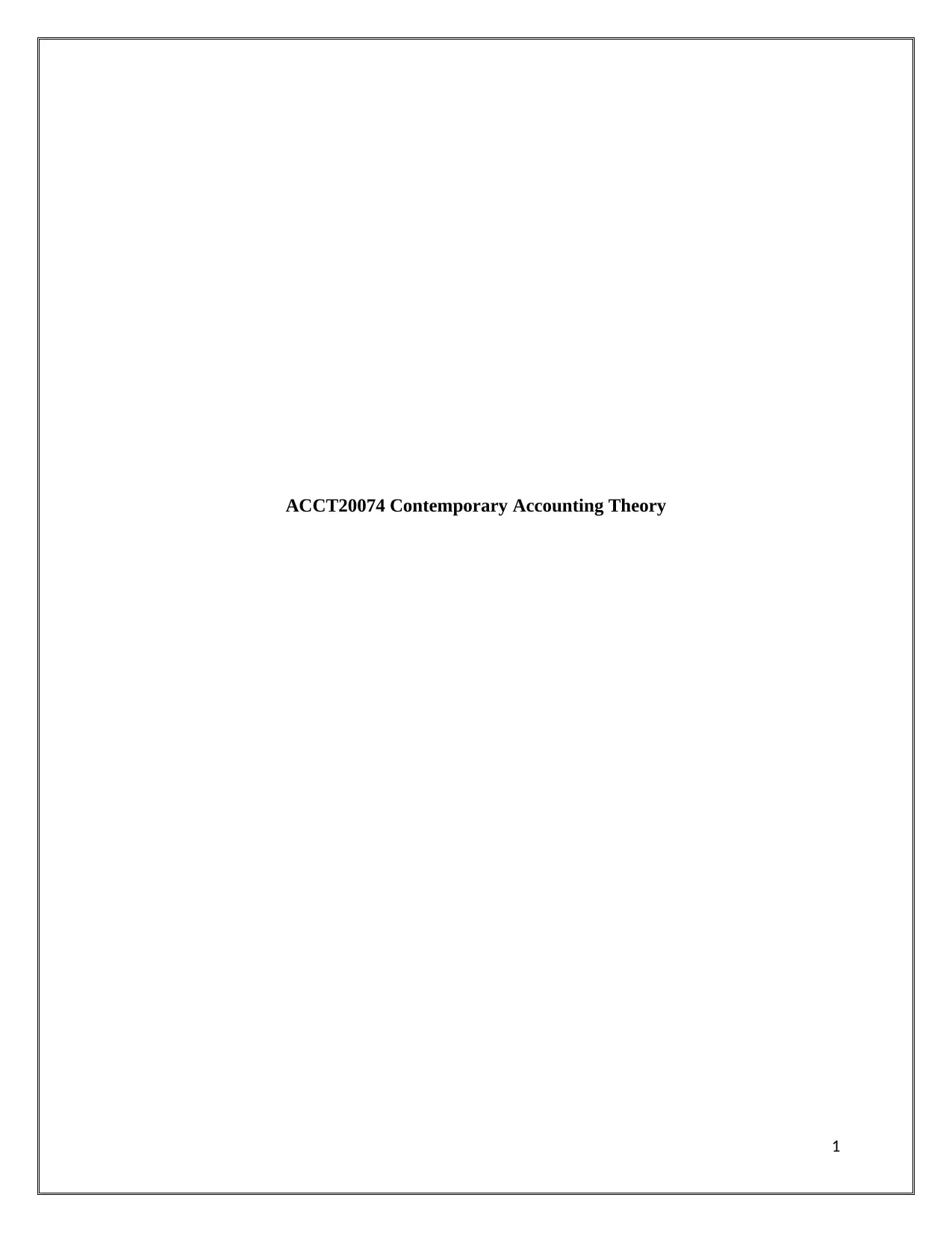
ACCT20074 Contemporary Accounting Theory
1
1
Secure Best Marks with AI Grader
Need help grading? Try our AI Grader for instant feedback on your assignments.
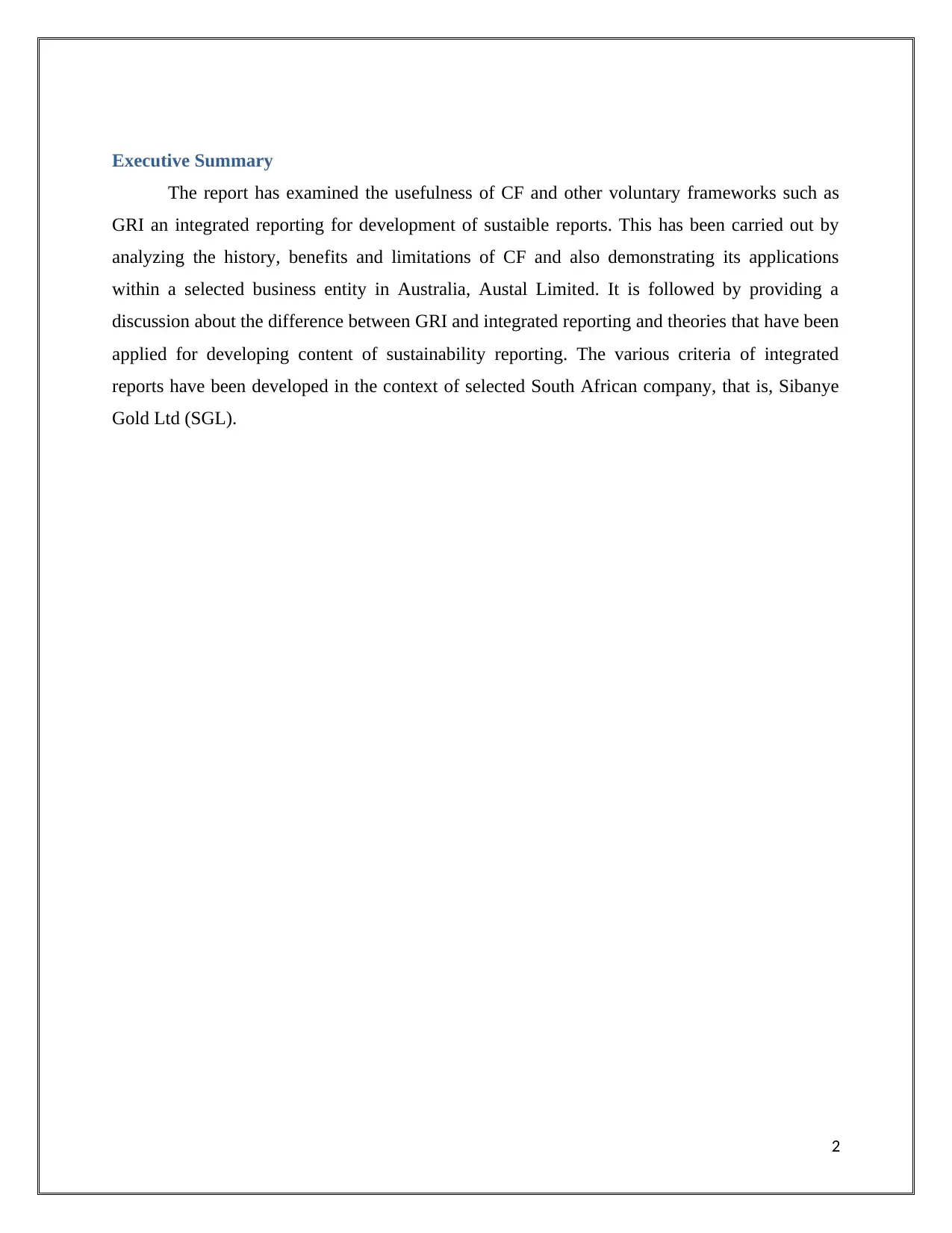
Executive Summary
The report has examined the usefulness of CF and other voluntary frameworks such as
GRI an integrated reporting for development of sustaible reports. This has been carried out by
analyzing the history, benefits and limitations of CF and also demonstrating its applications
within a selected business entity in Australia, Austal Limited. It is followed by providing a
discussion about the difference between GRI and integrated reporting and theories that have been
applied for developing content of sustainability reporting. The various criteria of integrated
reports have been developed in the context of selected South African company, that is, Sibanye
Gold Ltd (SGL).
2
The report has examined the usefulness of CF and other voluntary frameworks such as
GRI an integrated reporting for development of sustaible reports. This has been carried out by
analyzing the history, benefits and limitations of CF and also demonstrating its applications
within a selected business entity in Australia, Austal Limited. It is followed by providing a
discussion about the difference between GRI and integrated reporting and theories that have been
applied for developing content of sustainability reporting. The various criteria of integrated
reports have been developed in the context of selected South African company, that is, Sibanye
Gold Ltd (SGL).
2
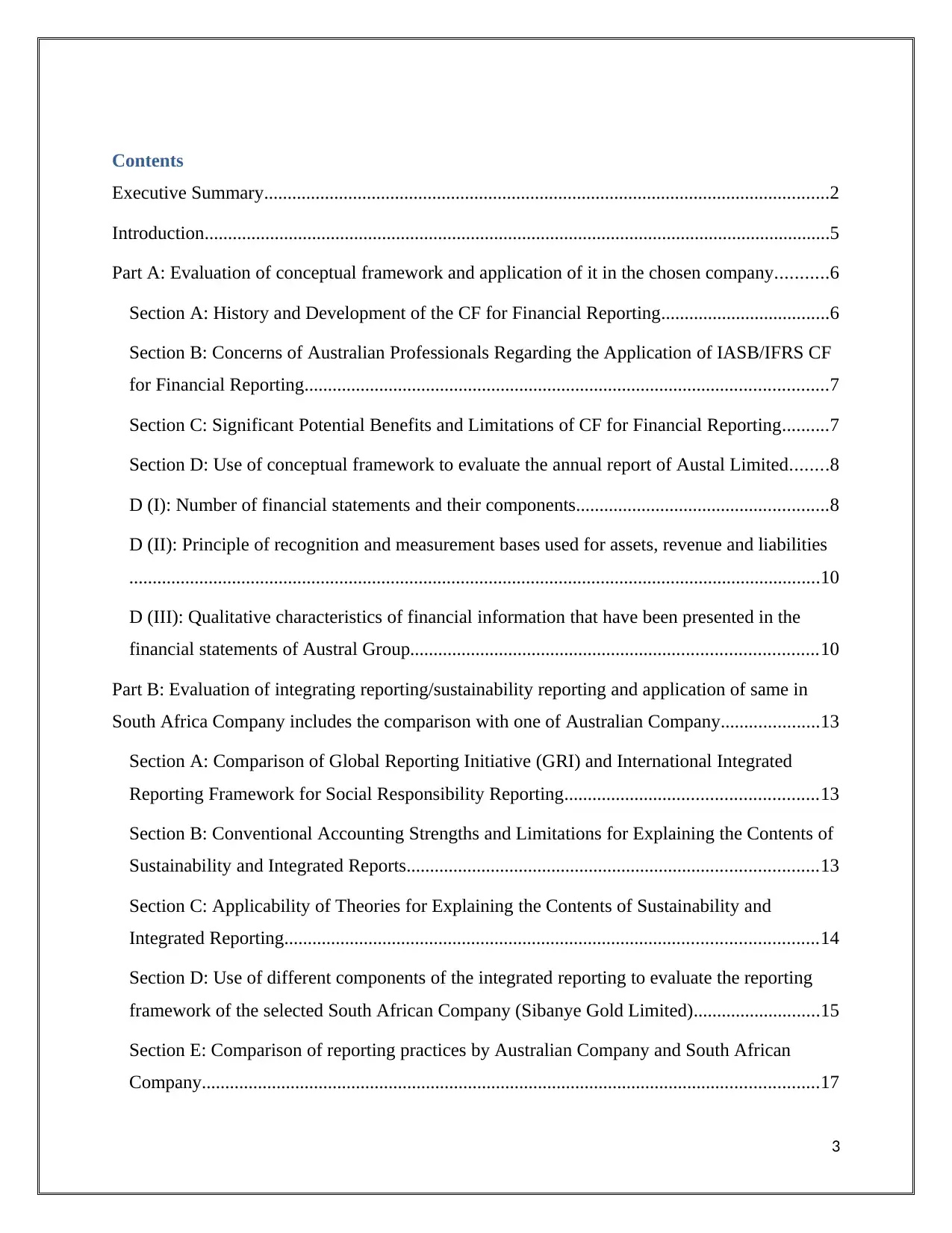
Contents
Executive Summary.........................................................................................................................2
Introduction......................................................................................................................................5
Part A: Evaluation of conceptual framework and application of it in the chosen company...........6
Section A: History and Development of the CF for Financial Reporting....................................6
Section B: Concerns of Australian Professionals Regarding the Application of IASB/IFRS CF
for Financial Reporting................................................................................................................7
Section C: Significant Potential Benefits and Limitations of CF for Financial Reporting..........7
Section D: Use of conceptual framework to evaluate the annual report of Austal Limited........8
D (I): Number of financial statements and their components......................................................8
D (II): Principle of recognition and measurement bases used for assets, revenue and liabilities
....................................................................................................................................................10
D (III): Qualitative characteristics of financial information that have been presented in the
financial statements of Austral Group.......................................................................................10
Part B: Evaluation of integrating reporting/sustainability reporting and application of same in
South Africa Company includes the comparison with one of Australian Company.....................13
Section A: Comparison of Global Reporting Initiative (GRI) and International Integrated
Reporting Framework for Social Responsibility Reporting......................................................13
Section B: Conventional Accounting Strengths and Limitations for Explaining the Contents of
Sustainability and Integrated Reports........................................................................................13
Section C: Applicability of Theories for Explaining the Contents of Sustainability and
Integrated Reporting..................................................................................................................14
Section D: Use of different components of the integrated reporting to evaluate the reporting
framework of the selected South African Company (Sibanye Gold Limited)...........................15
Section E: Comparison of reporting practices by Australian Company and South African
Company....................................................................................................................................17
3
Executive Summary.........................................................................................................................2
Introduction......................................................................................................................................5
Part A: Evaluation of conceptual framework and application of it in the chosen company...........6
Section A: History and Development of the CF for Financial Reporting....................................6
Section B: Concerns of Australian Professionals Regarding the Application of IASB/IFRS CF
for Financial Reporting................................................................................................................7
Section C: Significant Potential Benefits and Limitations of CF for Financial Reporting..........7
Section D: Use of conceptual framework to evaluate the annual report of Austal Limited........8
D (I): Number of financial statements and their components......................................................8
D (II): Principle of recognition and measurement bases used for assets, revenue and liabilities
....................................................................................................................................................10
D (III): Qualitative characteristics of financial information that have been presented in the
financial statements of Austral Group.......................................................................................10
Part B: Evaluation of integrating reporting/sustainability reporting and application of same in
South Africa Company includes the comparison with one of Australian Company.....................13
Section A: Comparison of Global Reporting Initiative (GRI) and International Integrated
Reporting Framework for Social Responsibility Reporting......................................................13
Section B: Conventional Accounting Strengths and Limitations for Explaining the Contents of
Sustainability and Integrated Reports........................................................................................13
Section C: Applicability of Theories for Explaining the Contents of Sustainability and
Integrated Reporting..................................................................................................................14
Section D: Use of different components of the integrated reporting to evaluate the reporting
framework of the selected South African Company (Sibanye Gold Limited)...........................15
Section E: Comparison of reporting practices by Australian Company and South African
Company....................................................................................................................................17
3
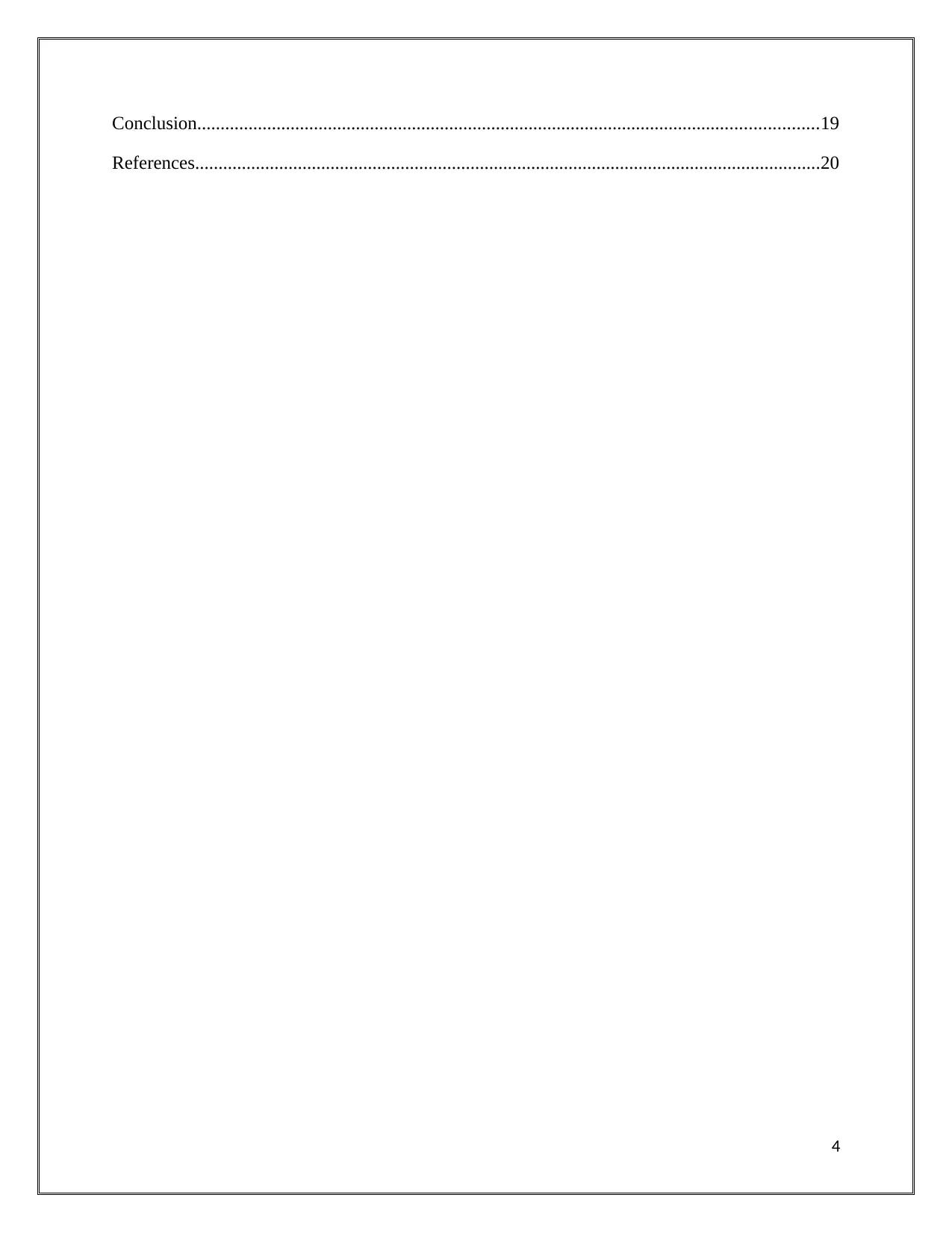
Conclusion.....................................................................................................................................19
References......................................................................................................................................20
4
References......................................................................................................................................20
4
Secure Best Marks with AI Grader
Need help grading? Try our AI Grader for instant feedback on your assignments.
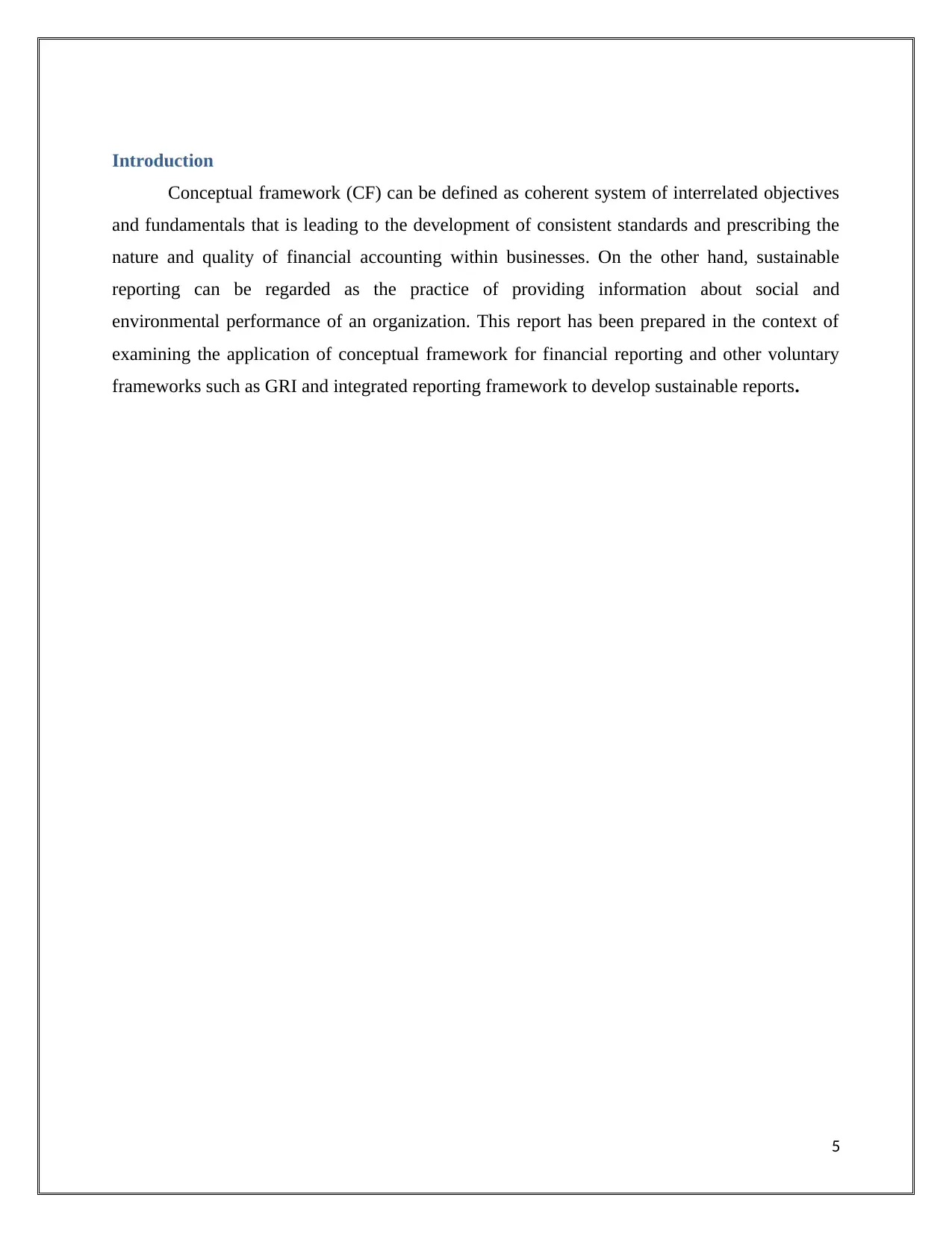
Introduction
Conceptual framework (CF) can be defined as coherent system of interrelated objectives
and fundamentals that is leading to the development of consistent standards and prescribing the
nature and quality of financial accounting within businesses. On the other hand, sustainable
reporting can be regarded as the practice of providing information about social and
environmental performance of an organization. This report has been prepared in the context of
examining the application of conceptual framework for financial reporting and other voluntary
frameworks such as GRI and integrated reporting framework to develop sustainable reports.
5
Conceptual framework (CF) can be defined as coherent system of interrelated objectives
and fundamentals that is leading to the development of consistent standards and prescribing the
nature and quality of financial accounting within businesses. On the other hand, sustainable
reporting can be regarded as the practice of providing information about social and
environmental performance of an organization. This report has been prepared in the context of
examining the application of conceptual framework for financial reporting and other voluntary
frameworks such as GRI and integrated reporting framework to develop sustainable reports.
5
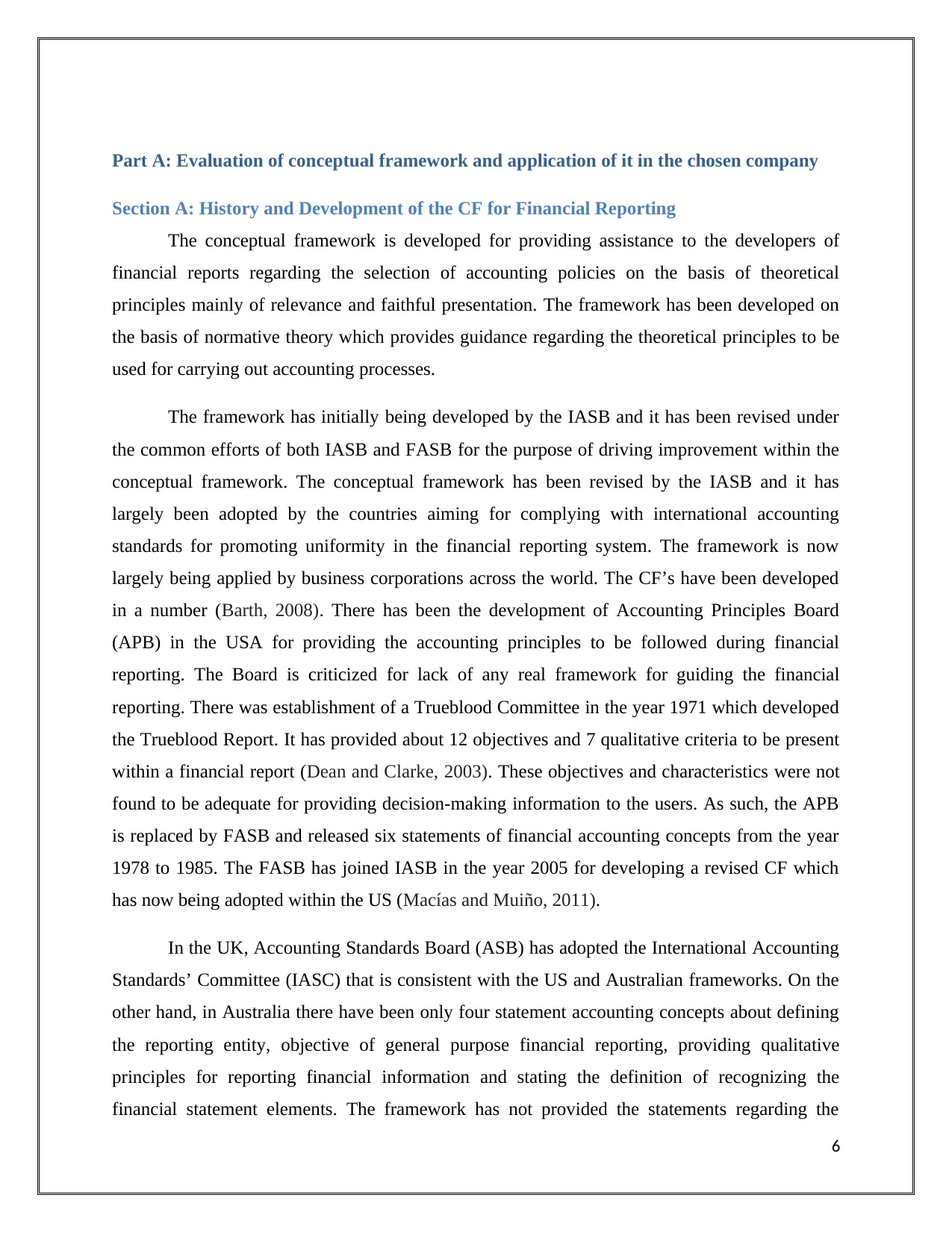
Part A: Evaluation of conceptual framework and application of it in the chosen company
Section A: History and Development of the CF for Financial Reporting
The conceptual framework is developed for providing assistance to the developers of
financial reports regarding the selection of accounting policies on the basis of theoretical
principles mainly of relevance and faithful presentation. The framework has been developed on
the basis of normative theory which provides guidance regarding the theoretical principles to be
used for carrying out accounting processes.
The framework has initially being developed by the IASB and it has been revised under
the common efforts of both IASB and FASB for the purpose of driving improvement within the
conceptual framework. The conceptual framework has been revised by the IASB and it has
largely been adopted by the countries aiming for complying with international accounting
standards for promoting uniformity in the financial reporting system. The framework is now
largely being applied by business corporations across the world. The CF’s have been developed
in a number (Barth, 2008). There has been the development of Accounting Principles Board
(APB) in the USA for providing the accounting principles to be followed during financial
reporting. The Board is criticized for lack of any real framework for guiding the financial
reporting. There was establishment of a Trueblood Committee in the year 1971 which developed
the Trueblood Report. It has provided about 12 objectives and 7 qualitative criteria to be present
within a financial report (Dean and Clarke, 2003). These objectives and characteristics were not
found to be adequate for providing decision-making information to the users. As such, the APB
is replaced by FASB and released six statements of financial accounting concepts from the year
1978 to 1985. The FASB has joined IASB in the year 2005 for developing a revised CF which
has now being adopted within the US (Macías and Muiño, 2011).
In the UK, Accounting Standards Board (ASB) has adopted the International Accounting
Standards’ Committee (IASC) that is consistent with the US and Australian frameworks. On the
other hand, in Australia there have been only four statement accounting concepts about defining
the reporting entity, objective of general purpose financial reporting, providing qualitative
principles for reporting financial information and stating the definition of recognizing the
financial statement elements. The framework has not provided the statements regarding the
6
Section A: History and Development of the CF for Financial Reporting
The conceptual framework is developed for providing assistance to the developers of
financial reports regarding the selection of accounting policies on the basis of theoretical
principles mainly of relevance and faithful presentation. The framework has been developed on
the basis of normative theory which provides guidance regarding the theoretical principles to be
used for carrying out accounting processes.
The framework has initially being developed by the IASB and it has been revised under
the common efforts of both IASB and FASB for the purpose of driving improvement within the
conceptual framework. The conceptual framework has been revised by the IASB and it has
largely been adopted by the countries aiming for complying with international accounting
standards for promoting uniformity in the financial reporting system. The framework is now
largely being applied by business corporations across the world. The CF’s have been developed
in a number (Barth, 2008). There has been the development of Accounting Principles Board
(APB) in the USA for providing the accounting principles to be followed during financial
reporting. The Board is criticized for lack of any real framework for guiding the financial
reporting. There was establishment of a Trueblood Committee in the year 1971 which developed
the Trueblood Report. It has provided about 12 objectives and 7 qualitative criteria to be present
within a financial report (Dean and Clarke, 2003). These objectives and characteristics were not
found to be adequate for providing decision-making information to the users. As such, the APB
is replaced by FASB and released six statements of financial accounting concepts from the year
1978 to 1985. The FASB has joined IASB in the year 2005 for developing a revised CF which
has now being adopted within the US (Macías and Muiño, 2011).
In the UK, Accounting Standards Board (ASB) has adopted the International Accounting
Standards’ Committee (IASC) that is consistent with the US and Australian frameworks. On the
other hand, in Australia there have been only four statement accounting concepts about defining
the reporting entity, objective of general purpose financial reporting, providing qualitative
principles for reporting financial information and stating the definition of recognizing the
financial statement elements. The framework has not provided the statements regarding the
6
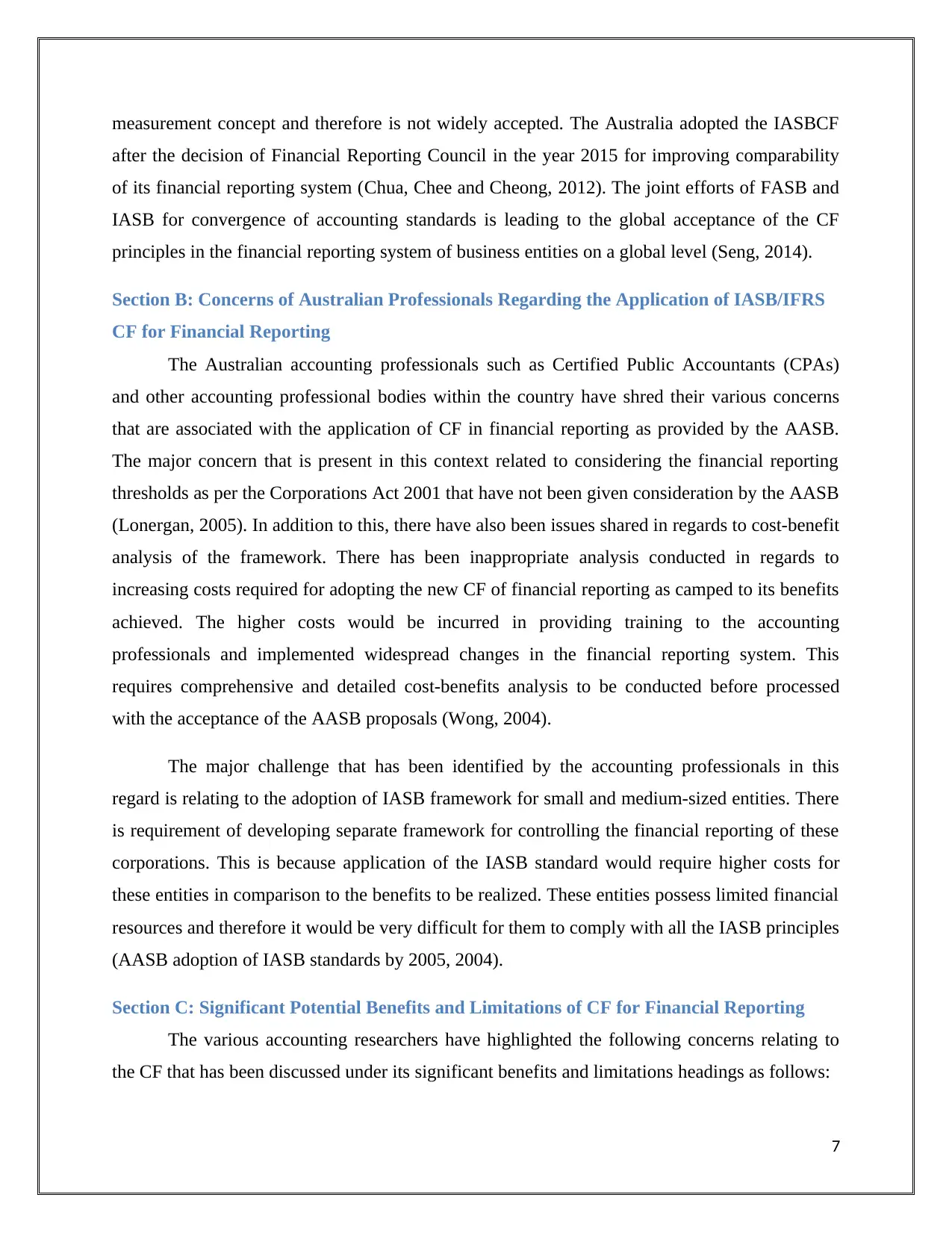
measurement concept and therefore is not widely accepted. The Australia adopted the IASBCF
after the decision of Financial Reporting Council in the year 2015 for improving comparability
of its financial reporting system (Chua, Chee and Cheong, 2012). The joint efforts of FASB and
IASB for convergence of accounting standards is leading to the global acceptance of the CF
principles in the financial reporting system of business entities on a global level (Seng, 2014).
Section B: Concerns of Australian Professionals Regarding the Application of IASB/IFRS
CF for Financial Reporting
The Australian accounting professionals such as Certified Public Accountants (CPAs)
and other accounting professional bodies within the country have shred their various concerns
that are associated with the application of CF in financial reporting as provided by the AASB.
The major concern that is present in this context related to considering the financial reporting
thresholds as per the Corporations Act 2001 that have not been given consideration by the AASB
(Lonergan, 2005). In addition to this, there have also been issues shared in regards to cost-benefit
analysis of the framework. There has been inappropriate analysis conducted in regards to
increasing costs required for adopting the new CF of financial reporting as camped to its benefits
achieved. The higher costs would be incurred in providing training to the accounting
professionals and implemented widespread changes in the financial reporting system. This
requires comprehensive and detailed cost-benefits analysis to be conducted before processed
with the acceptance of the AASB proposals (Wong, 2004).
The major challenge that has been identified by the accounting professionals in this
regard is relating to the adoption of IASB framework for small and medium-sized entities. There
is requirement of developing separate framework for controlling the financial reporting of these
corporations. This is because application of the IASB standard would require higher costs for
these entities in comparison to the benefits to be realized. These entities possess limited financial
resources and therefore it would be very difficult for them to comply with all the IASB principles
(AASB adoption of IASB standards by 2005, 2004).
Section C: Significant Potential Benefits and Limitations of CF for Financial Reporting
The various accounting researchers have highlighted the following concerns relating to
the CF that has been discussed under its significant benefits and limitations headings as follows:
7
after the decision of Financial Reporting Council in the year 2015 for improving comparability
of its financial reporting system (Chua, Chee and Cheong, 2012). The joint efforts of FASB and
IASB for convergence of accounting standards is leading to the global acceptance of the CF
principles in the financial reporting system of business entities on a global level (Seng, 2014).
Section B: Concerns of Australian Professionals Regarding the Application of IASB/IFRS
CF for Financial Reporting
The Australian accounting professionals such as Certified Public Accountants (CPAs)
and other accounting professional bodies within the country have shred their various concerns
that are associated with the application of CF in financial reporting as provided by the AASB.
The major concern that is present in this context related to considering the financial reporting
thresholds as per the Corporations Act 2001 that have not been given consideration by the AASB
(Lonergan, 2005). In addition to this, there have also been issues shared in regards to cost-benefit
analysis of the framework. There has been inappropriate analysis conducted in regards to
increasing costs required for adopting the new CF of financial reporting as camped to its benefits
achieved. The higher costs would be incurred in providing training to the accounting
professionals and implemented widespread changes in the financial reporting system. This
requires comprehensive and detailed cost-benefits analysis to be conducted before processed
with the acceptance of the AASB proposals (Wong, 2004).
The major challenge that has been identified by the accounting professionals in this
regard is relating to the adoption of IASB framework for small and medium-sized entities. There
is requirement of developing separate framework for controlling the financial reporting of these
corporations. This is because application of the IASB standard would require higher costs for
these entities in comparison to the benefits to be realized. These entities possess limited financial
resources and therefore it would be very difficult for them to comply with all the IASB principles
(AASB adoption of IASB standards by 2005, 2004).
Section C: Significant Potential Benefits and Limitations of CF for Financial Reporting
The various accounting researchers have highlighted the following concerns relating to
the CF that has been discussed under its significant benefits and limitations headings as follows:
7
Paraphrase This Document
Need a fresh take? Get an instant paraphrase of this document with our AI Paraphraser
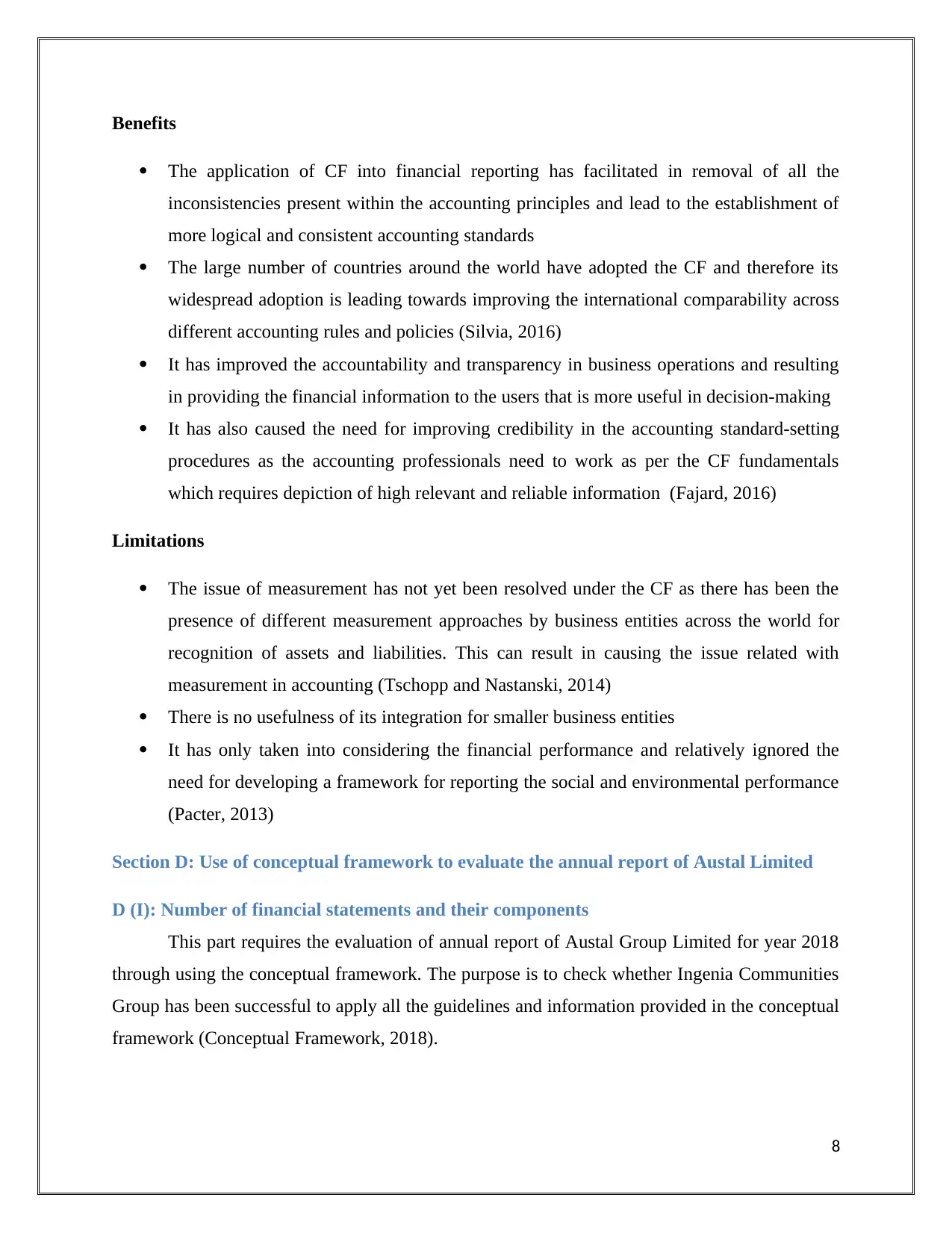
Benefits
The application of CF into financial reporting has facilitated in removal of all the
inconsistencies present within the accounting principles and lead to the establishment of
more logical and consistent accounting standards
The large number of countries around the world have adopted the CF and therefore its
widespread adoption is leading towards improving the international comparability across
different accounting rules and policies (Silvia, 2016)
It has improved the accountability and transparency in business operations and resulting
in providing the financial information to the users that is more useful in decision-making
It has also caused the need for improving credibility in the accounting standard-setting
procedures as the accounting professionals need to work as per the CF fundamentals
which requires depiction of high relevant and reliable information (Fajard, 2016)
Limitations
The issue of measurement has not yet been resolved under the CF as there has been the
presence of different measurement approaches by business entities across the world for
recognition of assets and liabilities. This can result in causing the issue related with
measurement in accounting (Tschopp and Nastanski, 2014)
There is no usefulness of its integration for smaller business entities
It has only taken into considering the financial performance and relatively ignored the
need for developing a framework for reporting the social and environmental performance
(Pacter, 2013)
Section D: Use of conceptual framework to evaluate the annual report of Austal Limited
D (I): Number of financial statements and their components
This part requires the evaluation of annual report of Austal Group Limited for year 2018
through using the conceptual framework. The purpose is to check whether Ingenia Communities
Group has been successful to apply all the guidelines and information provided in the conceptual
framework (Conceptual Framework, 2018).
8
The application of CF into financial reporting has facilitated in removal of all the
inconsistencies present within the accounting principles and lead to the establishment of
more logical and consistent accounting standards
The large number of countries around the world have adopted the CF and therefore its
widespread adoption is leading towards improving the international comparability across
different accounting rules and policies (Silvia, 2016)
It has improved the accountability and transparency in business operations and resulting
in providing the financial information to the users that is more useful in decision-making
It has also caused the need for improving credibility in the accounting standard-setting
procedures as the accounting professionals need to work as per the CF fundamentals
which requires depiction of high relevant and reliable information (Fajard, 2016)
Limitations
The issue of measurement has not yet been resolved under the CF as there has been the
presence of different measurement approaches by business entities across the world for
recognition of assets and liabilities. This can result in causing the issue related with
measurement in accounting (Tschopp and Nastanski, 2014)
There is no usefulness of its integration for smaller business entities
It has only taken into considering the financial performance and relatively ignored the
need for developing a framework for reporting the social and environmental performance
(Pacter, 2013)
Section D: Use of conceptual framework to evaluate the annual report of Austal Limited
D (I): Number of financial statements and their components
This part requires the evaluation of annual report of Austal Group Limited for year 2018
through using the conceptual framework. The purpose is to check whether Ingenia Communities
Group has been successful to apply all the guidelines and information provided in the conceptual
framework (Conceptual Framework, 2018).
8
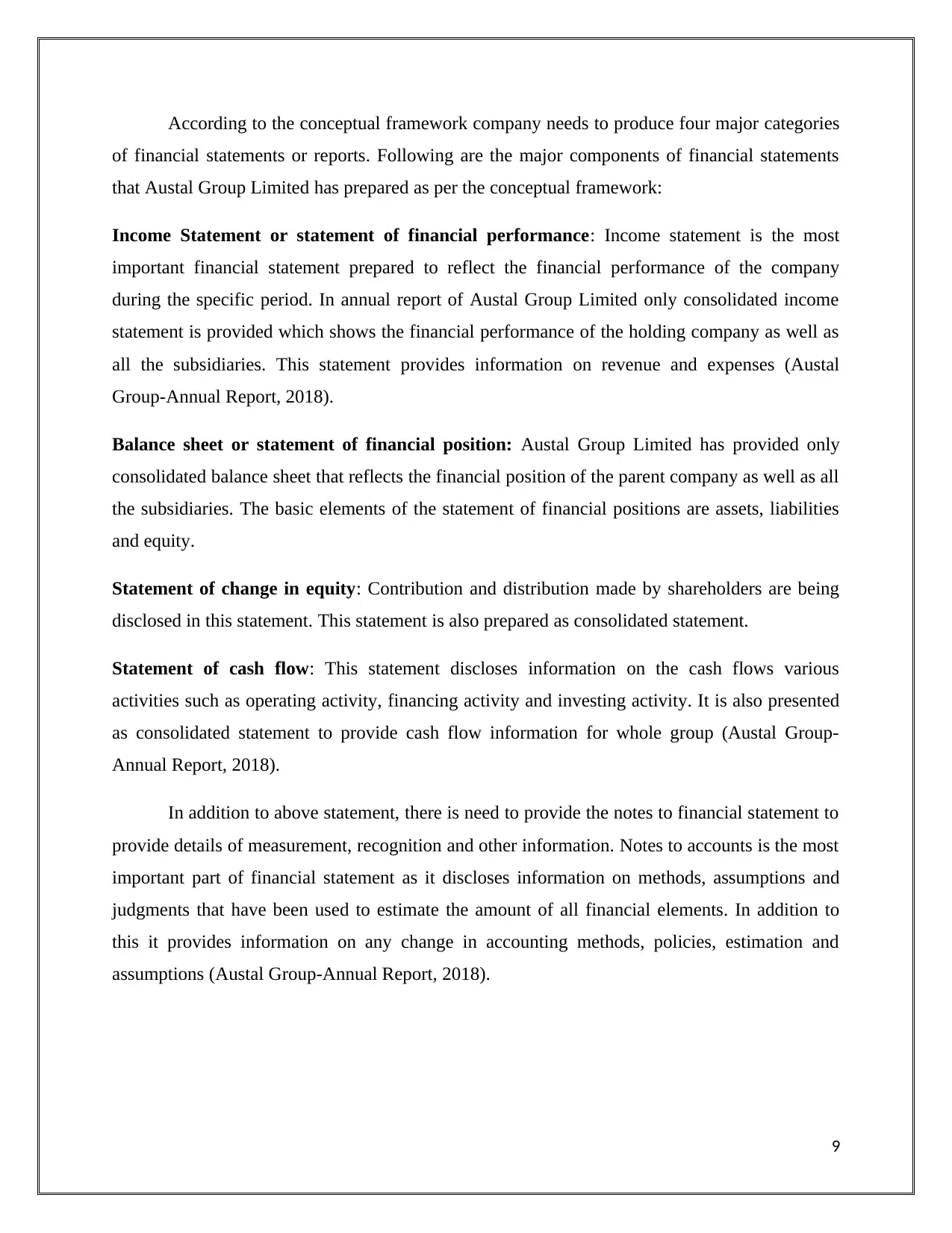
According to the conceptual framework company needs to produce four major categories
of financial statements or reports. Following are the major components of financial statements
that Austal Group Limited has prepared as per the conceptual framework:
Income Statement or statement of financial performance: Income statement is the most
important financial statement prepared to reflect the financial performance of the company
during the specific period. In annual report of Austal Group Limited only consolidated income
statement is provided which shows the financial performance of the holding company as well as
all the subsidiaries. This statement provides information on revenue and expenses (Austal
Group-Annual Report, 2018).
Balance sheet or statement of financial position: Austal Group Limited has provided only
consolidated balance sheet that reflects the financial position of the parent company as well as all
the subsidiaries. The basic elements of the statement of financial positions are assets, liabilities
and equity.
Statement of change in equity: Contribution and distribution made by shareholders are being
disclosed in this statement. This statement is also prepared as consolidated statement.
Statement of cash flow: This statement discloses information on the cash flows various
activities such as operating activity, financing activity and investing activity. It is also presented
as consolidated statement to provide cash flow information for whole group (Austal Group-
Annual Report, 2018).
In addition to above statement, there is need to provide the notes to financial statement to
provide details of measurement, recognition and other information. Notes to accounts is the most
important part of financial statement as it discloses information on methods, assumptions and
judgments that have been used to estimate the amount of all financial elements. In addition to
this it provides information on any change in accounting methods, policies, estimation and
assumptions (Austal Group-Annual Report, 2018).
9
of financial statements or reports. Following are the major components of financial statements
that Austal Group Limited has prepared as per the conceptual framework:
Income Statement or statement of financial performance: Income statement is the most
important financial statement prepared to reflect the financial performance of the company
during the specific period. In annual report of Austal Group Limited only consolidated income
statement is provided which shows the financial performance of the holding company as well as
all the subsidiaries. This statement provides information on revenue and expenses (Austal
Group-Annual Report, 2018).
Balance sheet or statement of financial position: Austal Group Limited has provided only
consolidated balance sheet that reflects the financial position of the parent company as well as all
the subsidiaries. The basic elements of the statement of financial positions are assets, liabilities
and equity.
Statement of change in equity: Contribution and distribution made by shareholders are being
disclosed in this statement. This statement is also prepared as consolidated statement.
Statement of cash flow: This statement discloses information on the cash flows various
activities such as operating activity, financing activity and investing activity. It is also presented
as consolidated statement to provide cash flow information for whole group (Austal Group-
Annual Report, 2018).
In addition to above statement, there is need to provide the notes to financial statement to
provide details of measurement, recognition and other information. Notes to accounts is the most
important part of financial statement as it discloses information on methods, assumptions and
judgments that have been used to estimate the amount of all financial elements. In addition to
this it provides information on any change in accounting methods, policies, estimation and
assumptions (Austal Group-Annual Report, 2018).
9
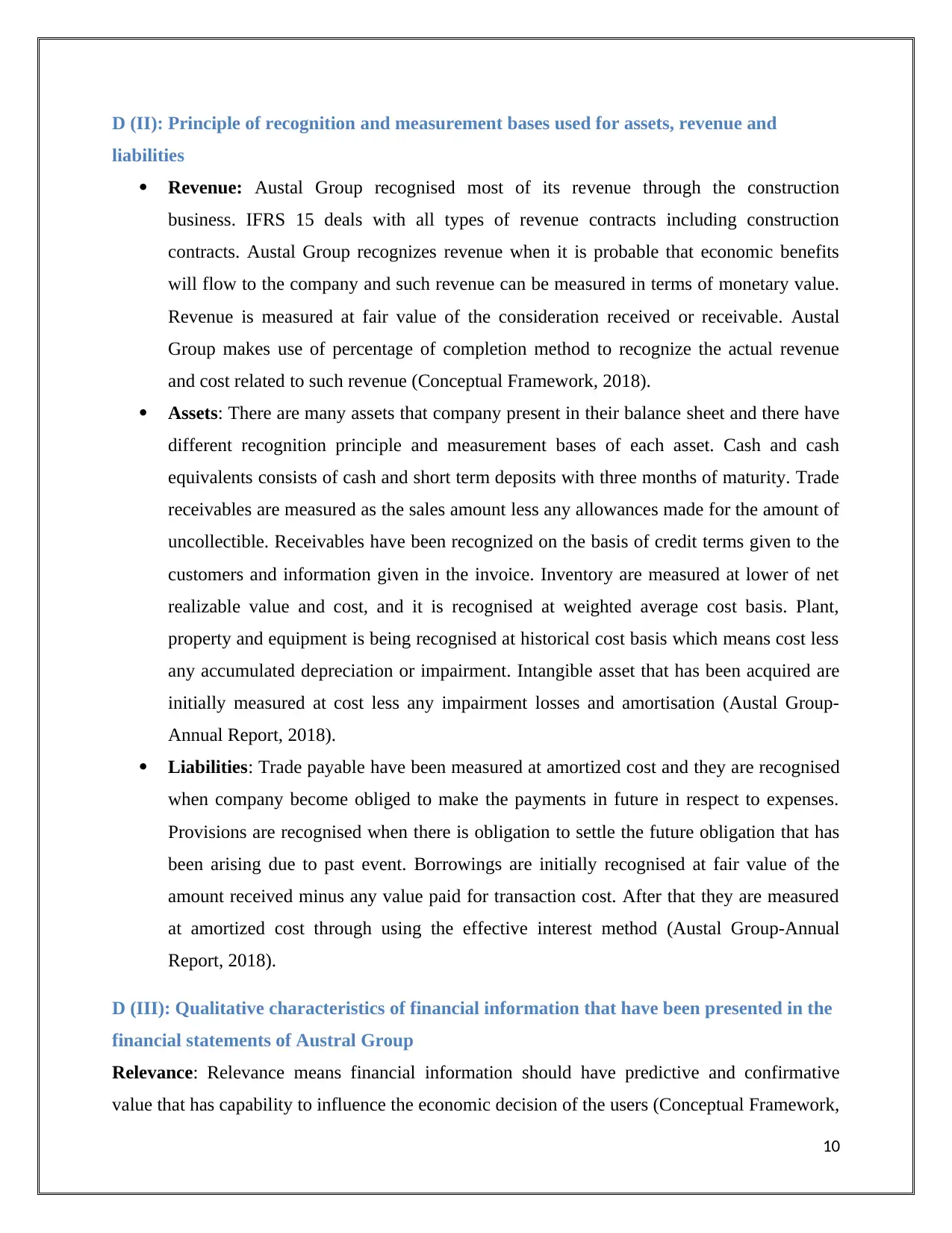
D (II): Principle of recognition and measurement bases used for assets, revenue and
liabilities
Revenue: Austal Group recognised most of its revenue through the construction
business. IFRS 15 deals with all types of revenue contracts including construction
contracts. Austal Group recognizes revenue when it is probable that economic benefits
will flow to the company and such revenue can be measured in terms of monetary value.
Revenue is measured at fair value of the consideration received or receivable. Austal
Group makes use of percentage of completion method to recognize the actual revenue
and cost related to such revenue (Conceptual Framework, 2018).
Assets: There are many assets that company present in their balance sheet and there have
different recognition principle and measurement bases of each asset. Cash and cash
equivalents consists of cash and short term deposits with three months of maturity. Trade
receivables are measured as the sales amount less any allowances made for the amount of
uncollectible. Receivables have been recognized on the basis of credit terms given to the
customers and information given in the invoice. Inventory are measured at lower of net
realizable value and cost, and it is recognised at weighted average cost basis. Plant,
property and equipment is being recognised at historical cost basis which means cost less
any accumulated depreciation or impairment. Intangible asset that has been acquired are
initially measured at cost less any impairment losses and amortisation (Austal Group-
Annual Report, 2018).
Liabilities: Trade payable have been measured at amortized cost and they are recognised
when company become obliged to make the payments in future in respect to expenses.
Provisions are recognised when there is obligation to settle the future obligation that has
been arising due to past event. Borrowings are initially recognised at fair value of the
amount received minus any value paid for transaction cost. After that they are measured
at amortized cost through using the effective interest method (Austal Group-Annual
Report, 2018).
D (III): Qualitative characteristics of financial information that have been presented in the
financial statements of Austral Group
Relevance: Relevance means financial information should have predictive and confirmative
value that has capability to influence the economic decision of the users (Conceptual Framework,
10
liabilities
Revenue: Austal Group recognised most of its revenue through the construction
business. IFRS 15 deals with all types of revenue contracts including construction
contracts. Austal Group recognizes revenue when it is probable that economic benefits
will flow to the company and such revenue can be measured in terms of monetary value.
Revenue is measured at fair value of the consideration received or receivable. Austal
Group makes use of percentage of completion method to recognize the actual revenue
and cost related to such revenue (Conceptual Framework, 2018).
Assets: There are many assets that company present in their balance sheet and there have
different recognition principle and measurement bases of each asset. Cash and cash
equivalents consists of cash and short term deposits with three months of maturity. Trade
receivables are measured as the sales amount less any allowances made for the amount of
uncollectible. Receivables have been recognized on the basis of credit terms given to the
customers and information given in the invoice. Inventory are measured at lower of net
realizable value and cost, and it is recognised at weighted average cost basis. Plant,
property and equipment is being recognised at historical cost basis which means cost less
any accumulated depreciation or impairment. Intangible asset that has been acquired are
initially measured at cost less any impairment losses and amortisation (Austal Group-
Annual Report, 2018).
Liabilities: Trade payable have been measured at amortized cost and they are recognised
when company become obliged to make the payments in future in respect to expenses.
Provisions are recognised when there is obligation to settle the future obligation that has
been arising due to past event. Borrowings are initially recognised at fair value of the
amount received minus any value paid for transaction cost. After that they are measured
at amortized cost through using the effective interest method (Austal Group-Annual
Report, 2018).
D (III): Qualitative characteristics of financial information that have been presented in the
financial statements of Austral Group
Relevance: Relevance means financial information should have predictive and confirmative
value that has capability to influence the economic decision of the users (Conceptual Framework,
10
Secure Best Marks with AI Grader
Need help grading? Try our AI Grader for instant feedback on your assignments.
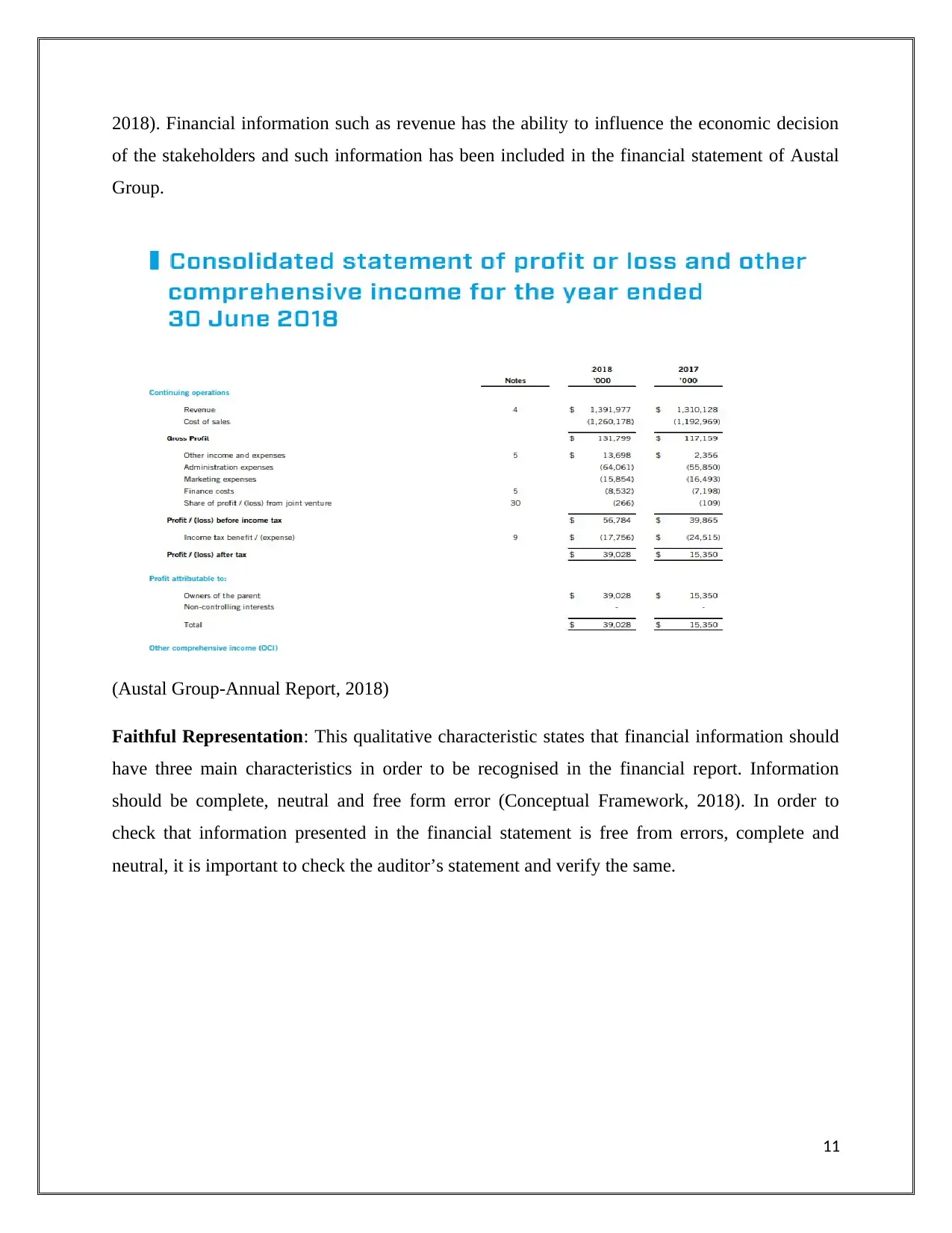
2018). Financial information such as revenue has the ability to influence the economic decision
of the stakeholders and such information has been included in the financial statement of Austal
Group.
(Austal Group-Annual Report, 2018)
Faithful Representation: This qualitative characteristic states that financial information should
have three main characteristics in order to be recognised in the financial report. Information
should be complete, neutral and free form error (Conceptual Framework, 2018). In order to
check that information presented in the financial statement is free from errors, complete and
neutral, it is important to check the auditor’s statement and verify the same.
11
of the stakeholders and such information has been included in the financial statement of Austal
Group.
(Austal Group-Annual Report, 2018)
Faithful Representation: This qualitative characteristic states that financial information should
have three main characteristics in order to be recognised in the financial report. Information
should be complete, neutral and free form error (Conceptual Framework, 2018). In order to
check that information presented in the financial statement is free from errors, complete and
neutral, it is important to check the auditor’s statement and verify the same.
11
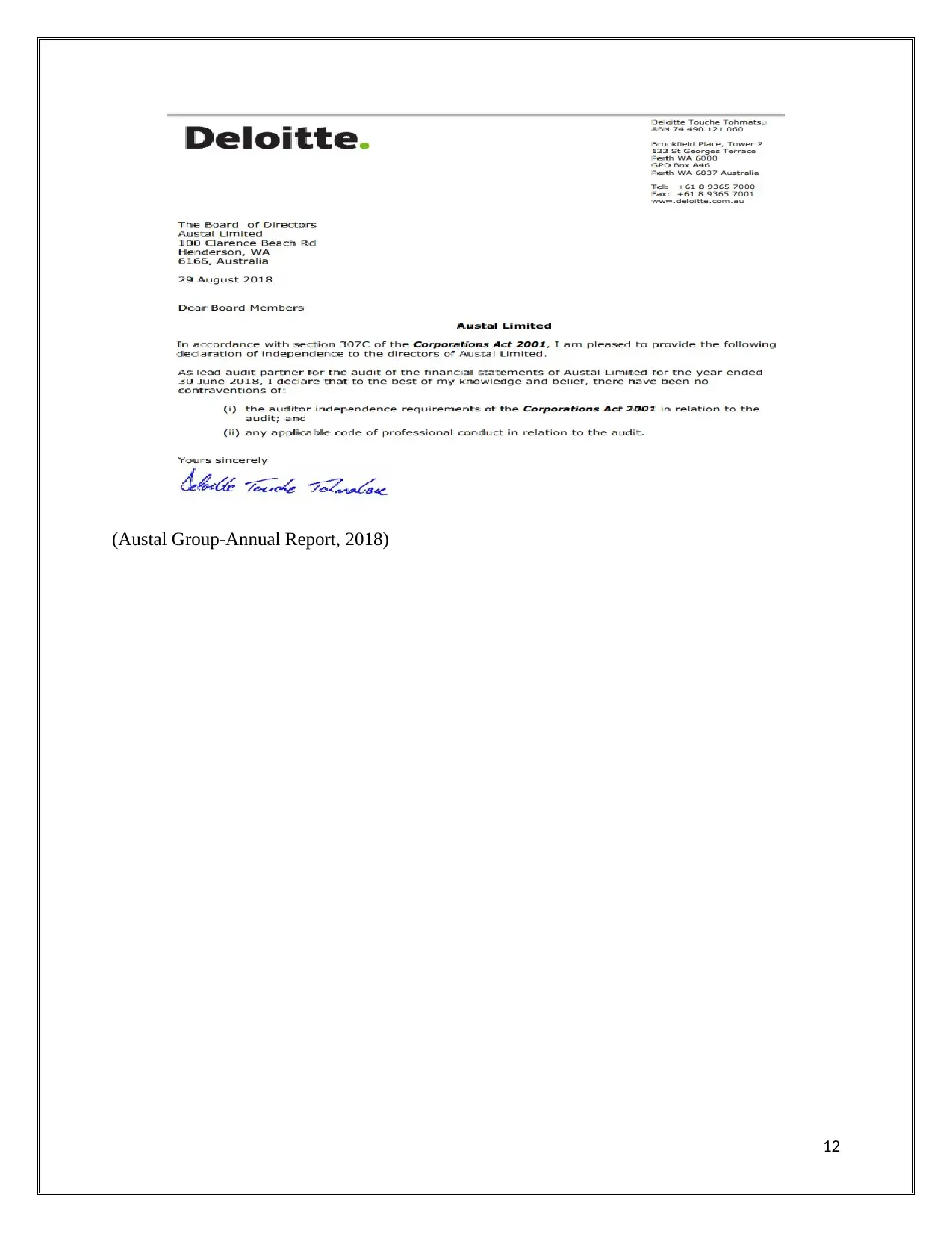
(Austal Group-Annual Report, 2018)
12
12
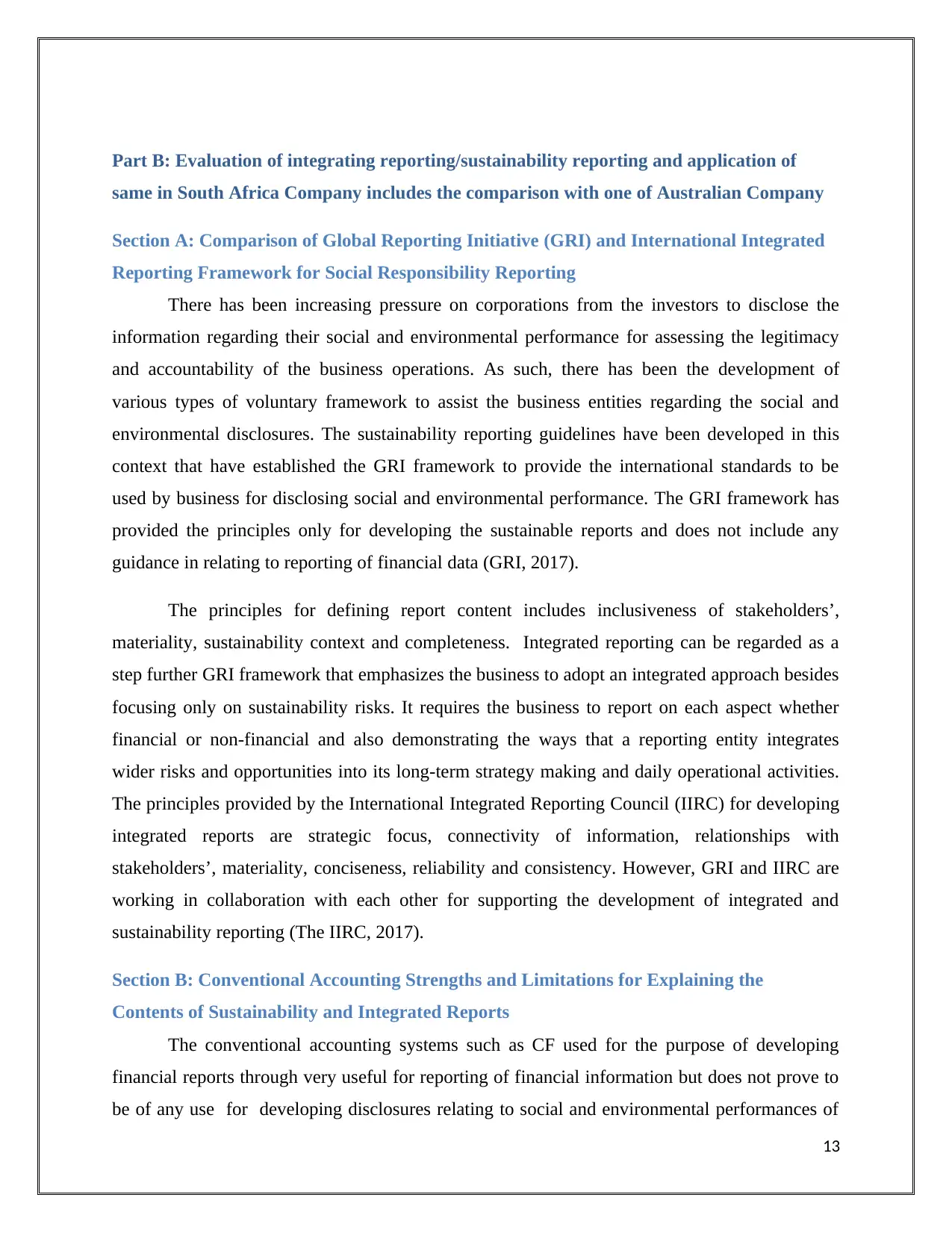
Part B: Evaluation of integrating reporting/sustainability reporting and application of
same in South Africa Company includes the comparison with one of Australian Company
Section A: Comparison of Global Reporting Initiative (GRI) and International Integrated
Reporting Framework for Social Responsibility Reporting
There has been increasing pressure on corporations from the investors to disclose the
information regarding their social and environmental performance for assessing the legitimacy
and accountability of the business operations. As such, there has been the development of
various types of voluntary framework to assist the business entities regarding the social and
environmental disclosures. The sustainability reporting guidelines have been developed in this
context that have established the GRI framework to provide the international standards to be
used by business for disclosing social and environmental performance. The GRI framework has
provided the principles only for developing the sustainable reports and does not include any
guidance in relating to reporting of financial data (GRI, 2017).
The principles for defining report content includes inclusiveness of stakeholders’,
materiality, sustainability context and completeness. Integrated reporting can be regarded as a
step further GRI framework that emphasizes the business to adopt an integrated approach besides
focusing only on sustainability risks. It requires the business to report on each aspect whether
financial or non-financial and also demonstrating the ways that a reporting entity integrates
wider risks and opportunities into its long-term strategy making and daily operational activities.
The principles provided by the International Integrated Reporting Council (IIRC) for developing
integrated reports are strategic focus, connectivity of information, relationships with
stakeholders’, materiality, conciseness, reliability and consistency. However, GRI and IIRC are
working in collaboration with each other for supporting the development of integrated and
sustainability reporting (The IIRC, 2017).
Section B: Conventional Accounting Strengths and Limitations for Explaining the
Contents of Sustainability and Integrated Reports
The conventional accounting systems such as CF used for the purpose of developing
financial reports through very useful for reporting of financial information but does not prove to
be of any use for developing disclosures relating to social and environmental performances of
13
same in South Africa Company includes the comparison with one of Australian Company
Section A: Comparison of Global Reporting Initiative (GRI) and International Integrated
Reporting Framework for Social Responsibility Reporting
There has been increasing pressure on corporations from the investors to disclose the
information regarding their social and environmental performance for assessing the legitimacy
and accountability of the business operations. As such, there has been the development of
various types of voluntary framework to assist the business entities regarding the social and
environmental disclosures. The sustainability reporting guidelines have been developed in this
context that have established the GRI framework to provide the international standards to be
used by business for disclosing social and environmental performance. The GRI framework has
provided the principles only for developing the sustainable reports and does not include any
guidance in relating to reporting of financial data (GRI, 2017).
The principles for defining report content includes inclusiveness of stakeholders’,
materiality, sustainability context and completeness. Integrated reporting can be regarded as a
step further GRI framework that emphasizes the business to adopt an integrated approach besides
focusing only on sustainability risks. It requires the business to report on each aspect whether
financial or non-financial and also demonstrating the ways that a reporting entity integrates
wider risks and opportunities into its long-term strategy making and daily operational activities.
The principles provided by the International Integrated Reporting Council (IIRC) for developing
integrated reports are strategic focus, connectivity of information, relationships with
stakeholders’, materiality, conciseness, reliability and consistency. However, GRI and IIRC are
working in collaboration with each other for supporting the development of integrated and
sustainability reporting (The IIRC, 2017).
Section B: Conventional Accounting Strengths and Limitations for Explaining the
Contents of Sustainability and Integrated Reports
The conventional accounting systems such as CF used for the purpose of developing
financial reports through very useful for reporting of financial information but does not prove to
be of any use for developing disclosures relating to social and environmental performances of
13
Paraphrase This Document
Need a fresh take? Get an instant paraphrase of this document with our AI Paraphraser
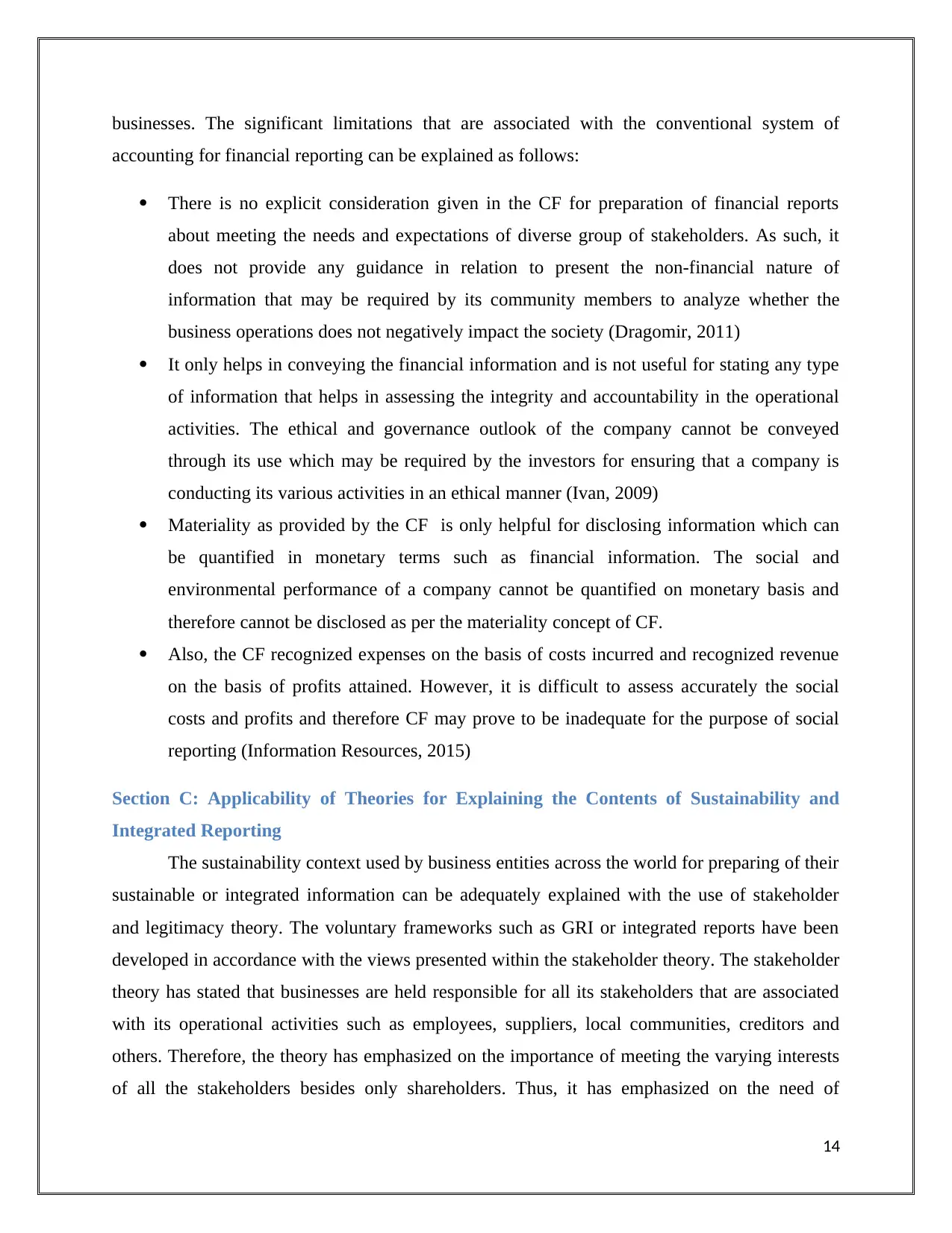
businesses. The significant limitations that are associated with the conventional system of
accounting for financial reporting can be explained as follows:
There is no explicit consideration given in the CF for preparation of financial reports
about meeting the needs and expectations of diverse group of stakeholders. As such, it
does not provide any guidance in relation to present the non-financial nature of
information that may be required by its community members to analyze whether the
business operations does not negatively impact the society (Dragomir, 2011)
It only helps in conveying the financial information and is not useful for stating any type
of information that helps in assessing the integrity and accountability in the operational
activities. The ethical and governance outlook of the company cannot be conveyed
through its use which may be required by the investors for ensuring that a company is
conducting its various activities in an ethical manner (Ivan, 2009)
Materiality as provided by the CF is only helpful for disclosing information which can
be quantified in monetary terms such as financial information. The social and
environmental performance of a company cannot be quantified on monetary basis and
therefore cannot be disclosed as per the materiality concept of CF.
Also, the CF recognized expenses on the basis of costs incurred and recognized revenue
on the basis of profits attained. However, it is difficult to assess accurately the social
costs and profits and therefore CF may prove to be inadequate for the purpose of social
reporting (Information Resources, 2015)
Section C: Applicability of Theories for Explaining the Contents of Sustainability and
Integrated Reporting
The sustainability context used by business entities across the world for preparing of their
sustainable or integrated information can be adequately explained with the use of stakeholder
and legitimacy theory. The voluntary frameworks such as GRI or integrated reports have been
developed in accordance with the views presented within the stakeholder theory. The stakeholder
theory has stated that businesses are held responsible for all its stakeholders that are associated
with its operational activities such as employees, suppliers, local communities, creditors and
others. Therefore, the theory has emphasized on the importance of meeting the varying interests
of all the stakeholders besides only shareholders. Thus, it has emphasized on the need of
14
accounting for financial reporting can be explained as follows:
There is no explicit consideration given in the CF for preparation of financial reports
about meeting the needs and expectations of diverse group of stakeholders. As such, it
does not provide any guidance in relation to present the non-financial nature of
information that may be required by its community members to analyze whether the
business operations does not negatively impact the society (Dragomir, 2011)
It only helps in conveying the financial information and is not useful for stating any type
of information that helps in assessing the integrity and accountability in the operational
activities. The ethical and governance outlook of the company cannot be conveyed
through its use which may be required by the investors for ensuring that a company is
conducting its various activities in an ethical manner (Ivan, 2009)
Materiality as provided by the CF is only helpful for disclosing information which can
be quantified in monetary terms such as financial information. The social and
environmental performance of a company cannot be quantified on monetary basis and
therefore cannot be disclosed as per the materiality concept of CF.
Also, the CF recognized expenses on the basis of costs incurred and recognized revenue
on the basis of profits attained. However, it is difficult to assess accurately the social
costs and profits and therefore CF may prove to be inadequate for the purpose of social
reporting (Information Resources, 2015)
Section C: Applicability of Theories for Explaining the Contents of Sustainability and
Integrated Reporting
The sustainability context used by business entities across the world for preparing of their
sustainable or integrated information can be adequately explained with the use of stakeholder
and legitimacy theory. The voluntary frameworks such as GRI or integrated reports have been
developed in accordance with the views presented within the stakeholder theory. The stakeholder
theory has stated that businesses are held responsible for all its stakeholders that are associated
with its operational activities such as employees, suppliers, local communities, creditors and
others. Therefore, the theory has emphasized on the importance of meeting the varying interests
of all the stakeholders besides only shareholders. Thus, it has emphasized on the need of
14
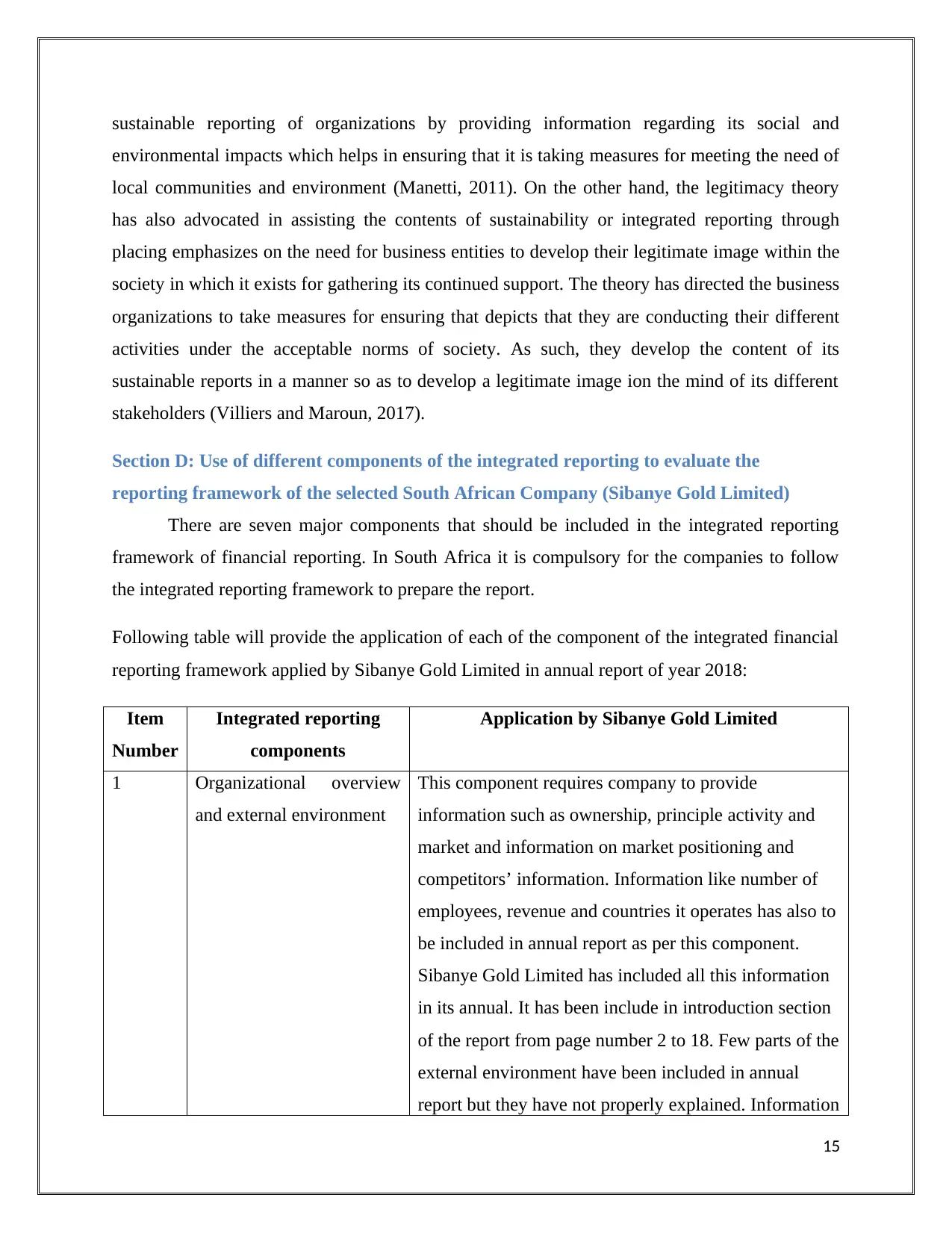
sustainable reporting of organizations by providing information regarding its social and
environmental impacts which helps in ensuring that it is taking measures for meeting the need of
local communities and environment (Manetti, 2011). On the other hand, the legitimacy theory
has also advocated in assisting the contents of sustainability or integrated reporting through
placing emphasizes on the need for business entities to develop their legitimate image within the
society in which it exists for gathering its continued support. The theory has directed the business
organizations to take measures for ensuring that depicts that they are conducting their different
activities under the acceptable norms of society. As such, they develop the content of its
sustainable reports in a manner so as to develop a legitimate image ion the mind of its different
stakeholders (Villiers and Maroun, 2017).
Section D: Use of different components of the integrated reporting to evaluate the
reporting framework of the selected South African Company (Sibanye Gold Limited)
There are seven major components that should be included in the integrated reporting
framework of financial reporting. In South Africa it is compulsory for the companies to follow
the integrated reporting framework to prepare the report.
Following table will provide the application of each of the component of the integrated financial
reporting framework applied by Sibanye Gold Limited in annual report of year 2018:
Item
Number
Integrated reporting
components
Application by Sibanye Gold Limited
1 Organizational overview
and external environment
This component requires company to provide
information such as ownership, principle activity and
market and information on market positioning and
competitors’ information. Information like number of
employees, revenue and countries it operates has also to
be included in annual report as per this component.
Sibanye Gold Limited has included all this information
in its annual. It has been include in introduction section
of the report from page number 2 to 18. Few parts of the
external environment have been included in annual
report but they have not properly explained. Information
15
environmental impacts which helps in ensuring that it is taking measures for meeting the need of
local communities and environment (Manetti, 2011). On the other hand, the legitimacy theory
has also advocated in assisting the contents of sustainability or integrated reporting through
placing emphasizes on the need for business entities to develop their legitimate image within the
society in which it exists for gathering its continued support. The theory has directed the business
organizations to take measures for ensuring that depicts that they are conducting their different
activities under the acceptable norms of society. As such, they develop the content of its
sustainable reports in a manner so as to develop a legitimate image ion the mind of its different
stakeholders (Villiers and Maroun, 2017).
Section D: Use of different components of the integrated reporting to evaluate the
reporting framework of the selected South African Company (Sibanye Gold Limited)
There are seven major components that should be included in the integrated reporting
framework of financial reporting. In South Africa it is compulsory for the companies to follow
the integrated reporting framework to prepare the report.
Following table will provide the application of each of the component of the integrated financial
reporting framework applied by Sibanye Gold Limited in annual report of year 2018:
Item
Number
Integrated reporting
components
Application by Sibanye Gold Limited
1 Organizational overview
and external environment
This component requires company to provide
information such as ownership, principle activity and
market and information on market positioning and
competitors’ information. Information like number of
employees, revenue and countries it operates has also to
be included in annual report as per this component.
Sibanye Gold Limited has included all this information
in its annual. It has been include in introduction section
of the report from page number 2 to 18. Few parts of the
external environment have been included in annual
report but they have not properly explained. Information
15
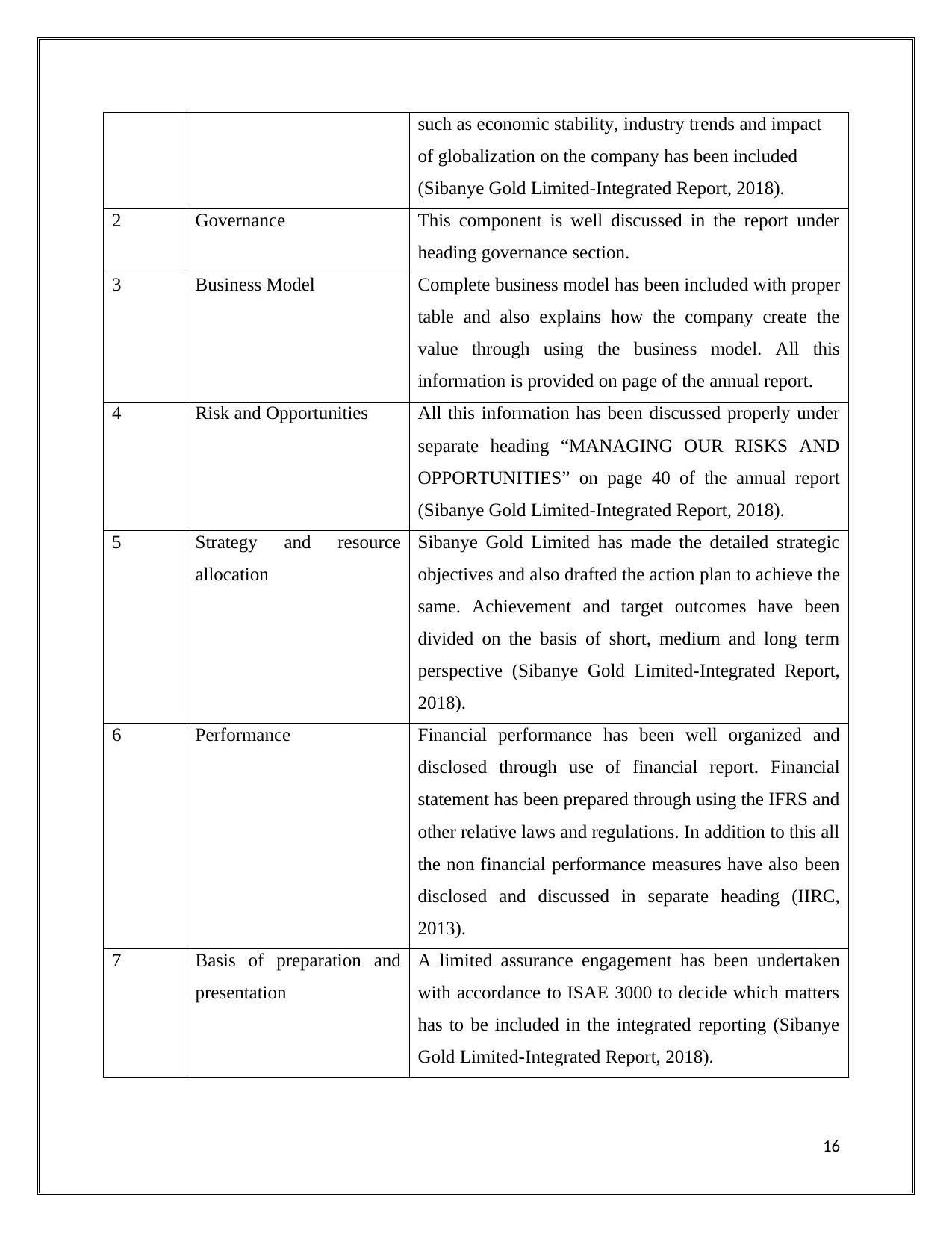
such as economic stability, industry trends and impact
of globalization on the company has been included
(Sibanye Gold Limited-Integrated Report, 2018).
2 Governance This component is well discussed in the report under
heading governance section.
3 Business Model Complete business model has been included with proper
table and also explains how the company create the
value through using the business model. All this
information is provided on page of the annual report.
4 Risk and Opportunities All this information has been discussed properly under
separate heading “MANAGING OUR RISKS AND
OPPORTUNITIES” on page 40 of the annual report
(Sibanye Gold Limited-Integrated Report, 2018).
5 Strategy and resource
allocation
Sibanye Gold Limited has made the detailed strategic
objectives and also drafted the action plan to achieve the
same. Achievement and target outcomes have been
divided on the basis of short, medium and long term
perspective (Sibanye Gold Limited-Integrated Report,
2018).
6 Performance Financial performance has been well organized and
disclosed through use of financial report. Financial
statement has been prepared through using the IFRS and
other relative laws and regulations. In addition to this all
the non financial performance measures have also been
disclosed and discussed in separate heading (IIRC,
2013).
7 Basis of preparation and
presentation
A limited assurance engagement has been undertaken
with accordance to ISAE 3000 to decide which matters
has to be included in the integrated reporting (Sibanye
Gold Limited-Integrated Report, 2018).
16
of globalization on the company has been included
(Sibanye Gold Limited-Integrated Report, 2018).
2 Governance This component is well discussed in the report under
heading governance section.
3 Business Model Complete business model has been included with proper
table and also explains how the company create the
value through using the business model. All this
information is provided on page of the annual report.
4 Risk and Opportunities All this information has been discussed properly under
separate heading “MANAGING OUR RISKS AND
OPPORTUNITIES” on page 40 of the annual report
(Sibanye Gold Limited-Integrated Report, 2018).
5 Strategy and resource
allocation
Sibanye Gold Limited has made the detailed strategic
objectives and also drafted the action plan to achieve the
same. Achievement and target outcomes have been
divided on the basis of short, medium and long term
perspective (Sibanye Gold Limited-Integrated Report,
2018).
6 Performance Financial performance has been well organized and
disclosed through use of financial report. Financial
statement has been prepared through using the IFRS and
other relative laws and regulations. In addition to this all
the non financial performance measures have also been
disclosed and discussed in separate heading (IIRC,
2013).
7 Basis of preparation and
presentation
A limited assurance engagement has been undertaken
with accordance to ISAE 3000 to decide which matters
has to be included in the integrated reporting (Sibanye
Gold Limited-Integrated Report, 2018).
16
Secure Best Marks with AI Grader
Need help grading? Try our AI Grader for instant feedback on your assignments.
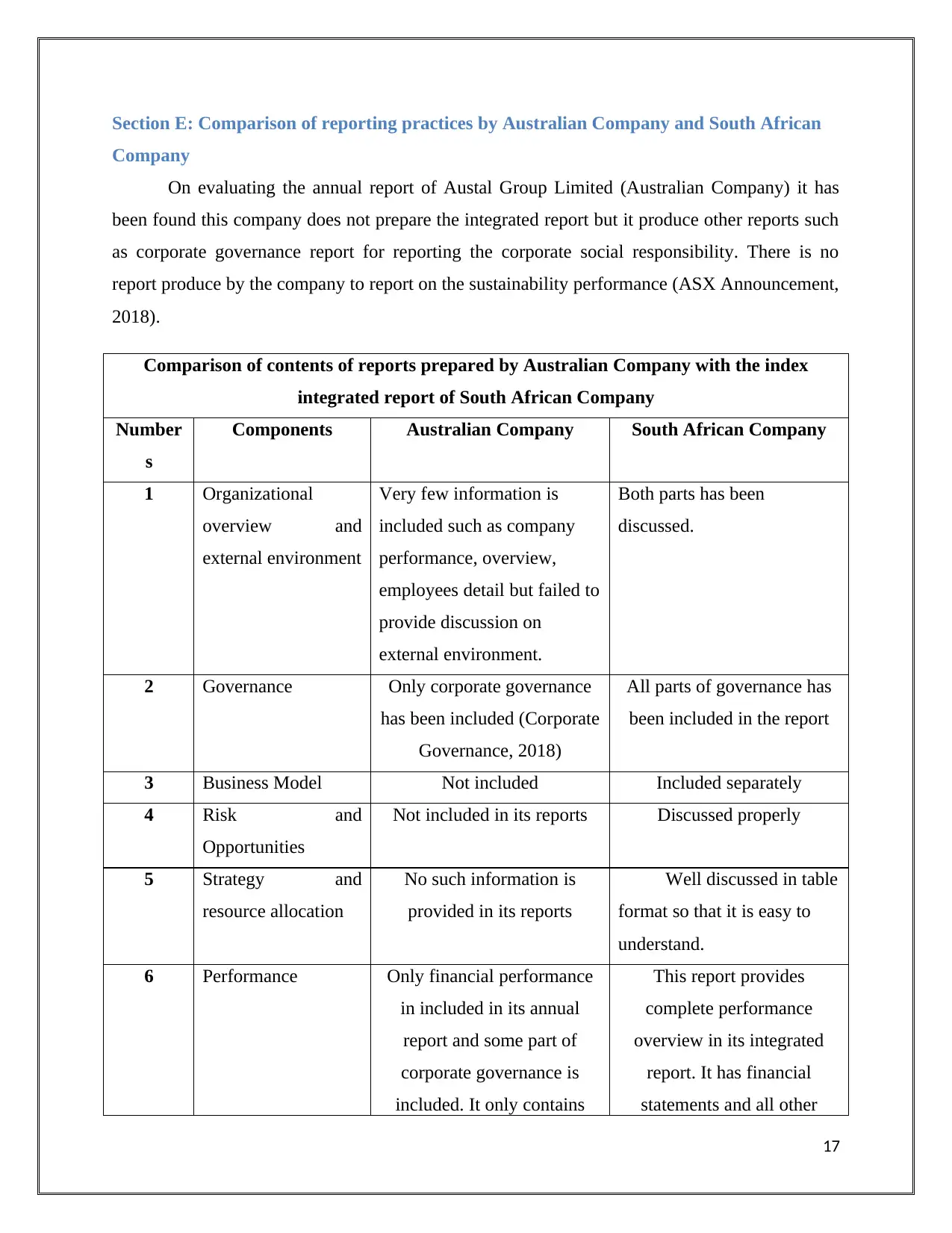
Section E: Comparison of reporting practices by Australian Company and South African
Company
On evaluating the annual report of Austal Group Limited (Australian Company) it has
been found this company does not prepare the integrated report but it produce other reports such
as corporate governance report for reporting the corporate social responsibility. There is no
report produce by the company to report on the sustainability performance (ASX Announcement,
2018).
Comparison of contents of reports prepared by Australian Company with the index
integrated report of South African Company
Number
s
Components Australian Company South African Company
1 Organizational
overview and
external environment
Very few information is
included such as company
performance, overview,
employees detail but failed to
provide discussion on
external environment.
Both parts has been
discussed.
2 Governance Only corporate governance
has been included (Corporate
Governance, 2018)
All parts of governance has
been included in the report
3 Business Model Not included Included separately
4 Risk and
Opportunities
Not included in its reports Discussed properly
5 Strategy and
resource allocation
No such information is
provided in its reports
Well discussed in table
format so that it is easy to
understand.
6 Performance Only financial performance
in included in its annual
report and some part of
corporate governance is
included. It only contains
This report provides
complete performance
overview in its integrated
report. It has financial
statements and all other
17
Company
On evaluating the annual report of Austal Group Limited (Australian Company) it has
been found this company does not prepare the integrated report but it produce other reports such
as corporate governance report for reporting the corporate social responsibility. There is no
report produce by the company to report on the sustainability performance (ASX Announcement,
2018).
Comparison of contents of reports prepared by Australian Company with the index
integrated report of South African Company
Number
s
Components Australian Company South African Company
1 Organizational
overview and
external environment
Very few information is
included such as company
performance, overview,
employees detail but failed to
provide discussion on
external environment.
Both parts has been
discussed.
2 Governance Only corporate governance
has been included (Corporate
Governance, 2018)
All parts of governance has
been included in the report
3 Business Model Not included Included separately
4 Risk and
Opportunities
Not included in its reports Discussed properly
5 Strategy and
resource allocation
No such information is
provided in its reports
Well discussed in table
format so that it is easy to
understand.
6 Performance Only financial performance
in included in its annual
report and some part of
corporate governance is
included. It only contains
This report provides
complete performance
overview in its integrated
report. It has financial
statements and all other
17
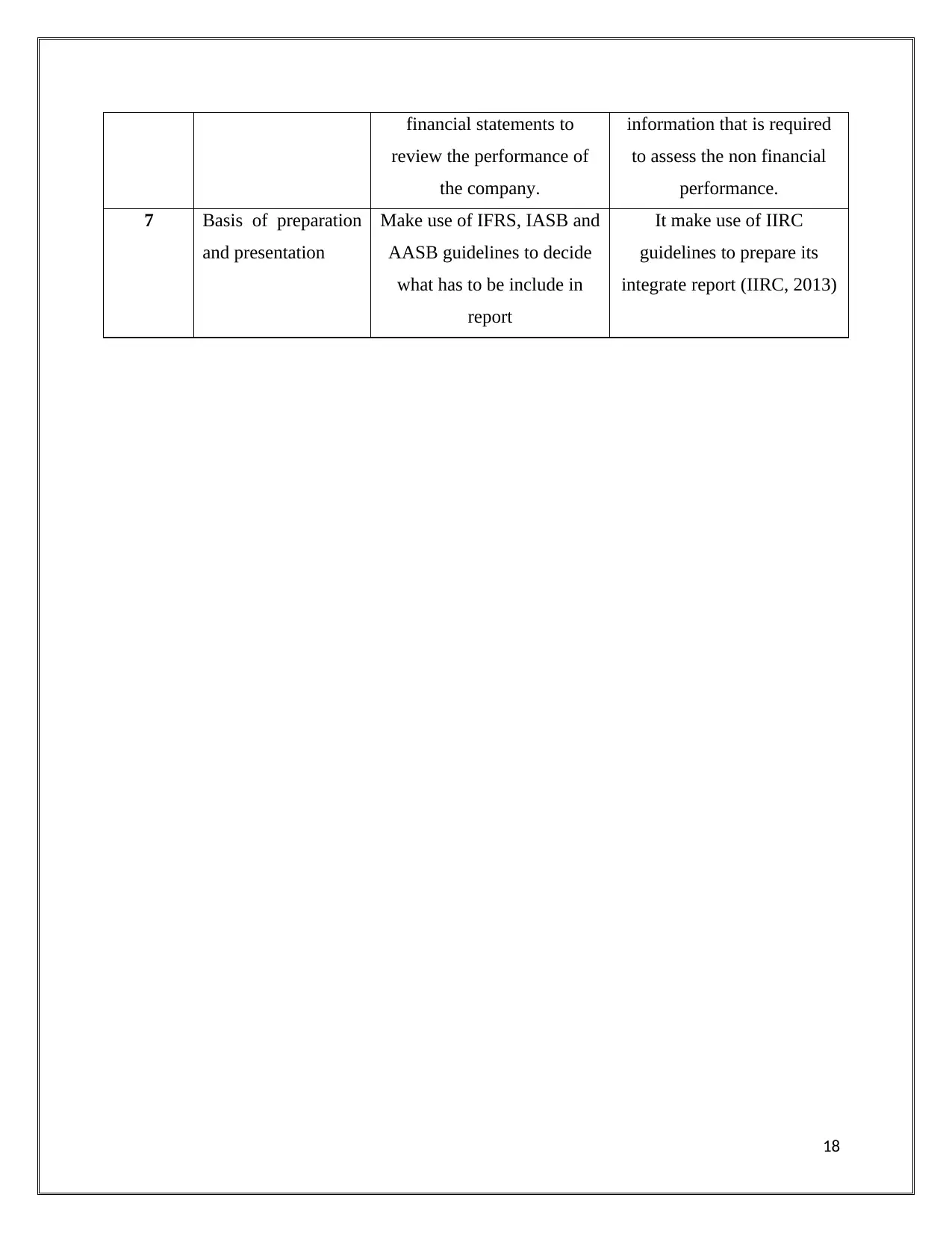
financial statements to
review the performance of
the company.
information that is required
to assess the non financial
performance.
7 Basis of preparation
and presentation
Make use of IFRS, IASB and
AASB guidelines to decide
what has to be include in
report
It make use of IIRC
guidelines to prepare its
integrate report (IIRC, 2013)
18
review the performance of
the company.
information that is required
to assess the non financial
performance.
7 Basis of preparation
and presentation
Make use of IFRS, IASB and
AASB guidelines to decide
what has to be include in
report
It make use of IIRC
guidelines to prepare its
integrate report (IIRC, 2013)
18
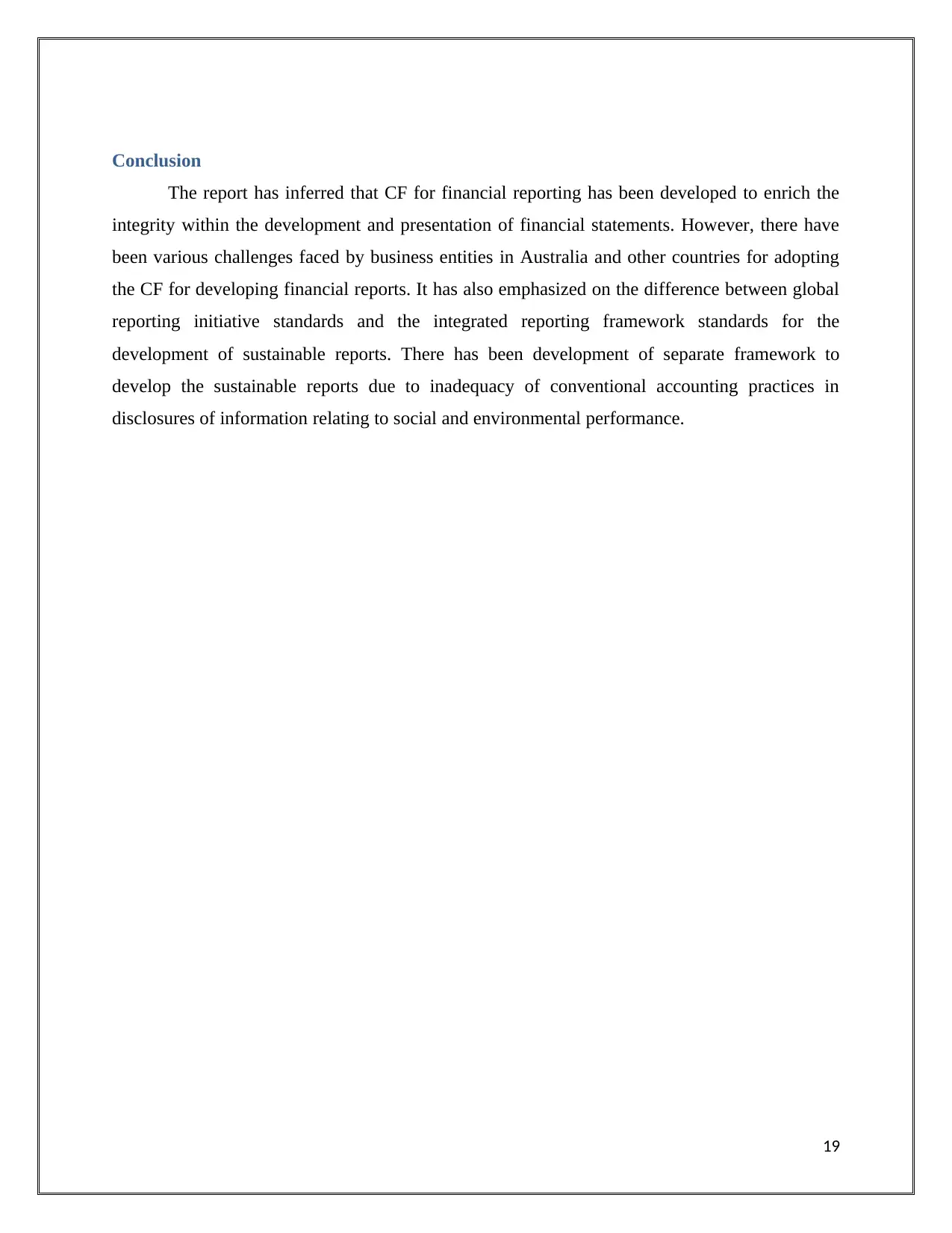
Conclusion
The report has inferred that CF for financial reporting has been developed to enrich the
integrity within the development and presentation of financial statements. However, there have
been various challenges faced by business entities in Australia and other countries for adopting
the CF for developing financial reports. It has also emphasized on the difference between global
reporting initiative standards and the integrated reporting framework standards for the
development of sustainable reports. There has been development of separate framework to
develop the sustainable reports due to inadequacy of conventional accounting practices in
disclosures of information relating to social and environmental performance.
19
The report has inferred that CF for financial reporting has been developed to enrich the
integrity within the development and presentation of financial statements. However, there have
been various challenges faced by business entities in Australia and other countries for adopting
the CF for developing financial reports. It has also emphasized on the difference between global
reporting initiative standards and the integrated reporting framework standards for the
development of sustainable reports. There has been development of separate framework to
develop the sustainable reports due to inadequacy of conventional accounting practices in
disclosures of information relating to social and environmental performance.
19
Paraphrase This Document
Need a fresh take? Get an instant paraphrase of this document with our AI Paraphraser
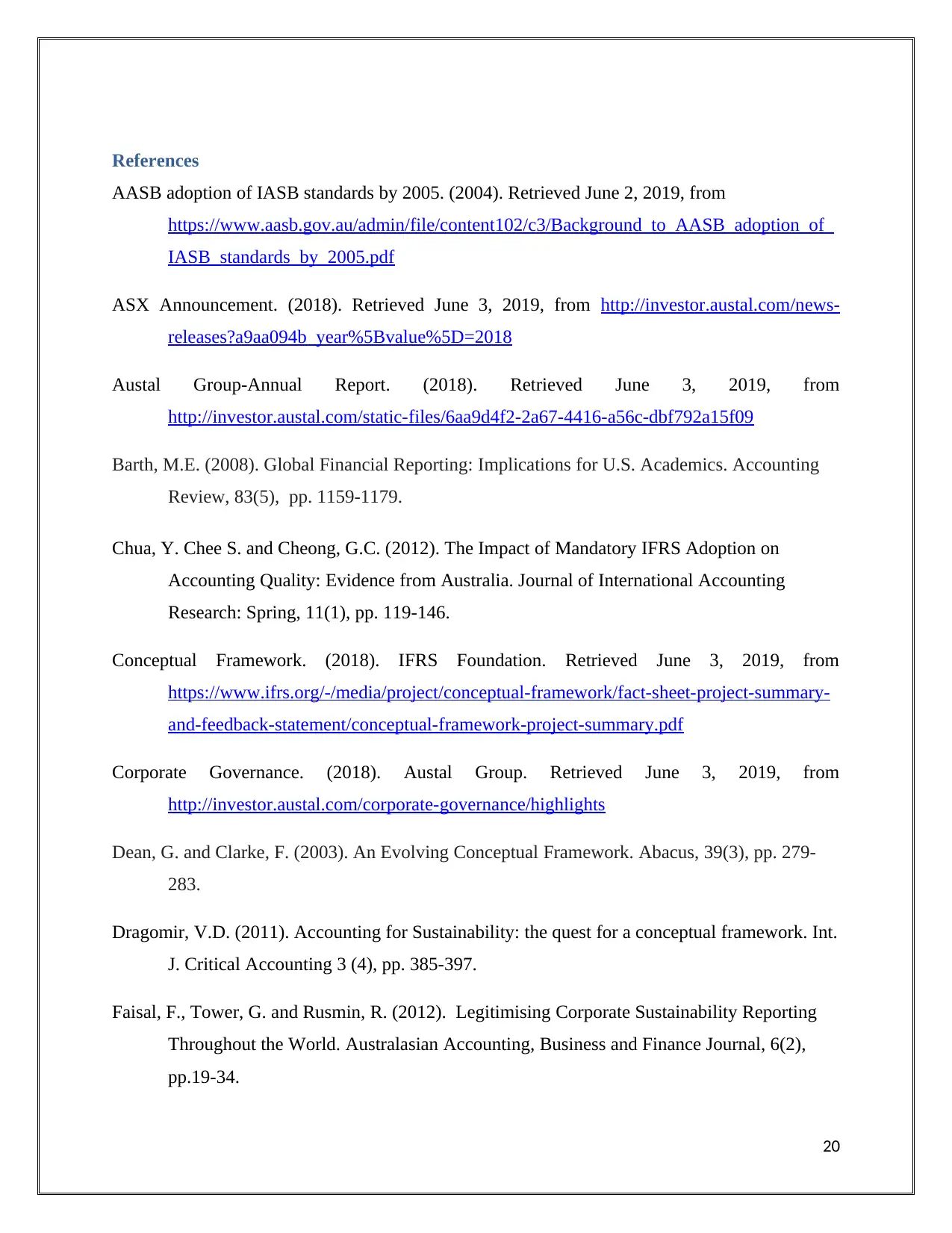
References
AASB adoption of IASB standards by 2005. (2004). Retrieved June 2, 2019, from
https://www.aasb.gov.au/admin/file/content102/c3/Background_to_AASB_adoption_of_
IASB_standards_by_2005.pdf
ASX Announcement. (2018). Retrieved June 3, 2019, from http://investor.austal.com/news-
releases?a9aa094b_year%5Bvalue%5D=2018
Austal Group-Annual Report. (2018). Retrieved June 3, 2019, from
http://investor.austal.com/static-files/6aa9d4f2-2a67-4416-a56c-dbf792a15f09
Barth, M.E. (2008). Global Financial Reporting: Implications for U.S. Academics. Accounting
Review, 83(5), pp. 1159-1179.
Chua, Y. Chee S. and Cheong, G.C. (2012). The Impact of Mandatory IFRS Adoption on
Accounting Quality: Evidence from Australia. Journal of International Accounting
Research: Spring, 11(1), pp. 119-146.
Conceptual Framework. (2018). IFRS Foundation. Retrieved June 3, 2019, from
https://www.ifrs.org/-/media/project/conceptual-framework/fact-sheet-project-summary-
and-feedback-statement/conceptual-framework-project-summary.pdf
Corporate Governance. (2018). Austal Group. Retrieved June 3, 2019, from
http://investor.austal.com/corporate-governance/highlights
Dean, G. and Clarke, F. (2003). An Evolving Conceptual Framework. Abacus, 39(3), pp. 279-
283.
Dragomir, V.D. (2011). Accounting for Sustainability: the quest for a conceptual framework. Int.
J. Critical Accounting 3 (4), pp. 385-397.
Faisal, F., Tower, G. and Rusmin, R. (2012). Legitimising Corporate Sustainability Reporting
Throughout the World. Australasian Accounting, Business and Finance Journal, 6(2),
pp.19-34.
20
AASB adoption of IASB standards by 2005. (2004). Retrieved June 2, 2019, from
https://www.aasb.gov.au/admin/file/content102/c3/Background_to_AASB_adoption_of_
IASB_standards_by_2005.pdf
ASX Announcement. (2018). Retrieved June 3, 2019, from http://investor.austal.com/news-
releases?a9aa094b_year%5Bvalue%5D=2018
Austal Group-Annual Report. (2018). Retrieved June 3, 2019, from
http://investor.austal.com/static-files/6aa9d4f2-2a67-4416-a56c-dbf792a15f09
Barth, M.E. (2008). Global Financial Reporting: Implications for U.S. Academics. Accounting
Review, 83(5), pp. 1159-1179.
Chua, Y. Chee S. and Cheong, G.C. (2012). The Impact of Mandatory IFRS Adoption on
Accounting Quality: Evidence from Australia. Journal of International Accounting
Research: Spring, 11(1), pp. 119-146.
Conceptual Framework. (2018). IFRS Foundation. Retrieved June 3, 2019, from
https://www.ifrs.org/-/media/project/conceptual-framework/fact-sheet-project-summary-
and-feedback-statement/conceptual-framework-project-summary.pdf
Corporate Governance. (2018). Austal Group. Retrieved June 3, 2019, from
http://investor.austal.com/corporate-governance/highlights
Dean, G. and Clarke, F. (2003). An Evolving Conceptual Framework. Abacus, 39(3), pp. 279-
283.
Dragomir, V.D. (2011). Accounting for Sustainability: the quest for a conceptual framework. Int.
J. Critical Accounting 3 (4), pp. 385-397.
Faisal, F., Tower, G. and Rusmin, R. (2012). Legitimising Corporate Sustainability Reporting
Throughout the World. Australasian Accounting, Business and Finance Journal, 6(2),
pp.19-34.
20
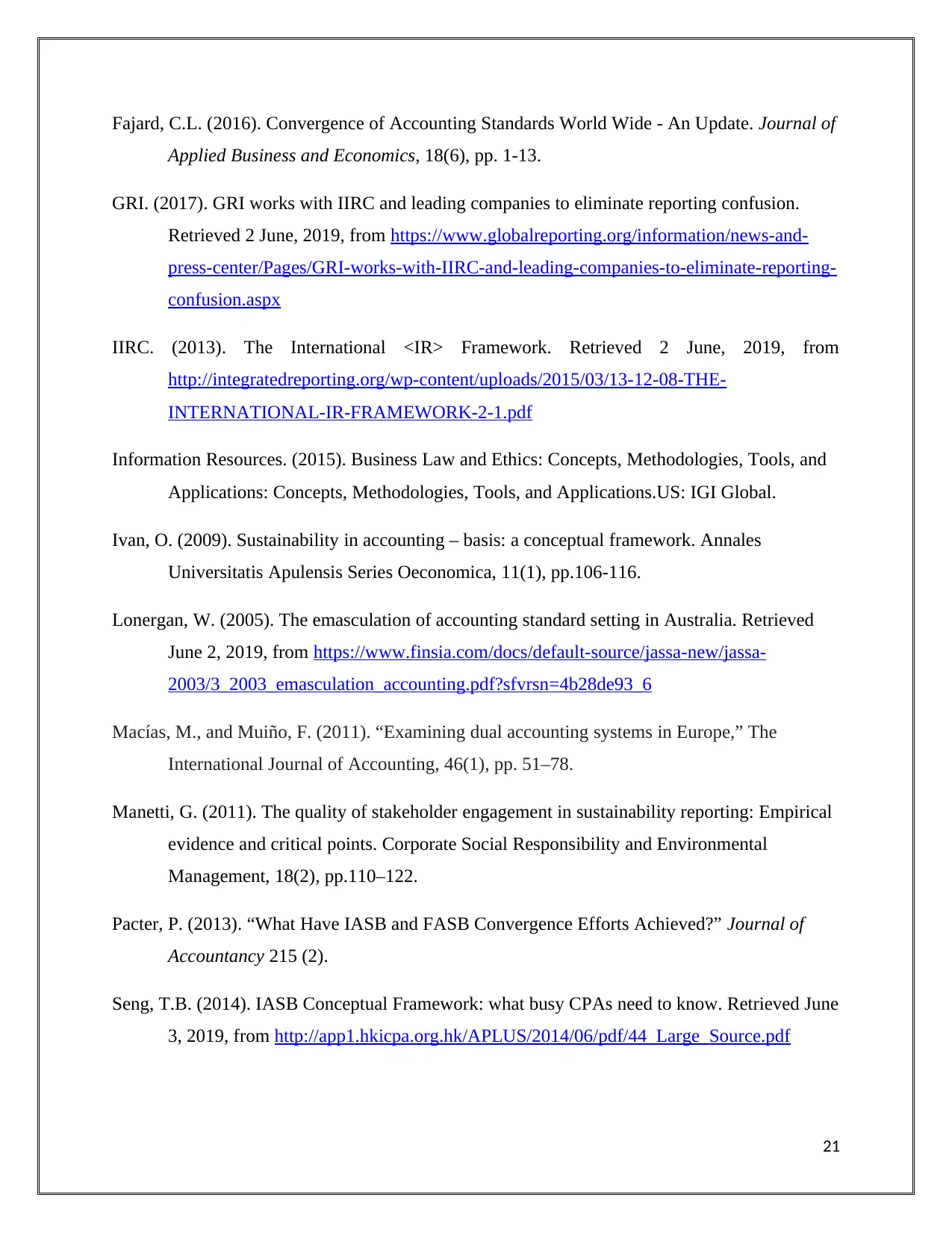
Fajard, C.L. (2016). Convergence of Accounting Standards World Wide - An Update. Journal of
Applied Business and Economics, 18(6), pp. 1-13.
GRI. (2017). GRI works with IIRC and leading companies to eliminate reporting confusion.
Retrieved 2 June, 2019, from https://www.globalreporting.org/information/news-and-
press-center/Pages/GRI-works-with-IIRC-and-leading-companies-to-eliminate-reporting-
confusion.aspx
IIRC. (2013). The International <IR> Framework. Retrieved 2 June, 2019, from
http://integratedreporting.org/wp-content/uploads/2015/03/13-12-08-THE-
INTERNATIONAL-IR-FRAMEWORK-2-1.pdf
Information Resources. (2015). Business Law and Ethics: Concepts, Methodologies, Tools, and
Applications: Concepts, Methodologies, Tools, and Applications.US: IGI Global.
Ivan, O. (2009). Sustainability in accounting – basis: a conceptual framework. Annales
Universitatis Apulensis Series Oeconomica, 11(1), pp.106-116.
Lonergan, W. (2005). The emasculation of accounting standard setting in Australia. Retrieved
June 2, 2019, from https://www.finsia.com/docs/default-source/jassa-new/jassa-
2003/3_2003_emasculation_accounting.pdf?sfvrsn=4b28de93_6
Macías, M., and Muiño, F. (2011). “Examining dual accounting systems in Europe,” The
International Journal of Accounting, 46(1), pp. 51–78.
Manetti, G. (2011). The quality of stakeholder engagement in sustainability reporting: Empirical
evidence and critical points. Corporate Social Responsibility and Environmental
Management, 18(2), pp.110–122.
Pacter, P. (2013). “What Have IASB and FASB Convergence Efforts Achieved?” Journal of
Accountancy 215 (2).
Seng, T.B. (2014). IASB Conceptual Framework: what busy CPAs need to know. Retrieved June
3, 2019, from http://app1.hkicpa.org.hk/APLUS/2014/06/pdf/44_Large_Source.pdf
21
Applied Business and Economics, 18(6), pp. 1-13.
GRI. (2017). GRI works with IIRC and leading companies to eliminate reporting confusion.
Retrieved 2 June, 2019, from https://www.globalreporting.org/information/news-and-
press-center/Pages/GRI-works-with-IIRC-and-leading-companies-to-eliminate-reporting-
confusion.aspx
IIRC. (2013). The International <IR> Framework. Retrieved 2 June, 2019, from
http://integratedreporting.org/wp-content/uploads/2015/03/13-12-08-THE-
INTERNATIONAL-IR-FRAMEWORK-2-1.pdf
Information Resources. (2015). Business Law and Ethics: Concepts, Methodologies, Tools, and
Applications: Concepts, Methodologies, Tools, and Applications.US: IGI Global.
Ivan, O. (2009). Sustainability in accounting – basis: a conceptual framework. Annales
Universitatis Apulensis Series Oeconomica, 11(1), pp.106-116.
Lonergan, W. (2005). The emasculation of accounting standard setting in Australia. Retrieved
June 2, 2019, from https://www.finsia.com/docs/default-source/jassa-new/jassa-
2003/3_2003_emasculation_accounting.pdf?sfvrsn=4b28de93_6
Macías, M., and Muiño, F. (2011). “Examining dual accounting systems in Europe,” The
International Journal of Accounting, 46(1), pp. 51–78.
Manetti, G. (2011). The quality of stakeholder engagement in sustainability reporting: Empirical
evidence and critical points. Corporate Social Responsibility and Environmental
Management, 18(2), pp.110–122.
Pacter, P. (2013). “What Have IASB and FASB Convergence Efforts Achieved?” Journal of
Accountancy 215 (2).
Seng, T.B. (2014). IASB Conceptual Framework: what busy CPAs need to know. Retrieved June
3, 2019, from http://app1.hkicpa.org.hk/APLUS/2014/06/pdf/44_Large_Source.pdf
21
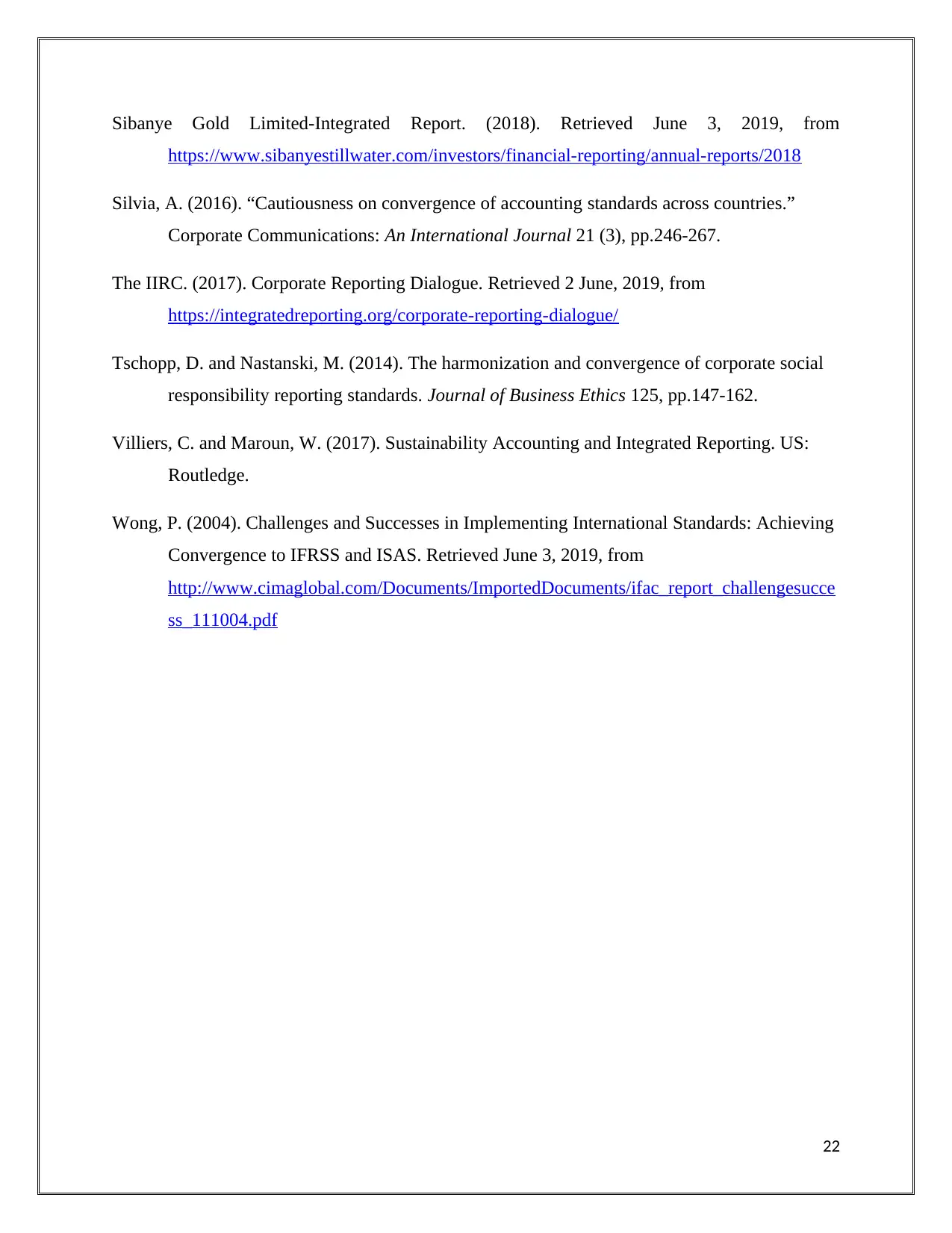
Sibanye Gold Limited-Integrated Report. (2018). Retrieved June 3, 2019, from
https://www.sibanyestillwater.com/investors/financial-reporting/annual-reports/2018
Silvia, A. (2016). “Cautiousness on convergence of accounting standards across countries.”
Corporate Communications: An International Journal 21 (3), pp.246-267.
The IIRC. (2017). Corporate Reporting Dialogue. Retrieved 2 June, 2019, from
https://integratedreporting.org/corporate-reporting-dialogue/
Tschopp, D. and Nastanski, M. (2014). The harmonization and convergence of corporate social
responsibility reporting standards. Journal of Business Ethics 125, pp.147-162.
Villiers, C. and Maroun, W. (2017). Sustainability Accounting and Integrated Reporting. US:
Routledge.
Wong, P. (2004). Challenges and Successes in Implementing International Standards: Achieving
Convergence to IFRSS and ISAS. Retrieved June 3, 2019, from
http://www.cimaglobal.com/Documents/ImportedDocuments/ifac_report_challengesucce
ss_111004.pdf
22
https://www.sibanyestillwater.com/investors/financial-reporting/annual-reports/2018
Silvia, A. (2016). “Cautiousness on convergence of accounting standards across countries.”
Corporate Communications: An International Journal 21 (3), pp.246-267.
The IIRC. (2017). Corporate Reporting Dialogue. Retrieved 2 June, 2019, from
https://integratedreporting.org/corporate-reporting-dialogue/
Tschopp, D. and Nastanski, M. (2014). The harmonization and convergence of corporate social
responsibility reporting standards. Journal of Business Ethics 125, pp.147-162.
Villiers, C. and Maroun, W. (2017). Sustainability Accounting and Integrated Reporting. US:
Routledge.
Wong, P. (2004). Challenges and Successes in Implementing International Standards: Achieving
Convergence to IFRSS and ISAS. Retrieved June 3, 2019, from
http://www.cimaglobal.com/Documents/ImportedDocuments/ifac_report_challengesucce
ss_111004.pdf
22
1 out of 22
Related Documents
Your All-in-One AI-Powered Toolkit for Academic Success.
+13062052269
info@desklib.com
Available 24*7 on WhatsApp / Email
![[object Object]](/_next/static/media/star-bottom.7253800d.svg)
Unlock your academic potential
© 2024 | Zucol Services PVT LTD | All rights reserved.





